ISSUE 6




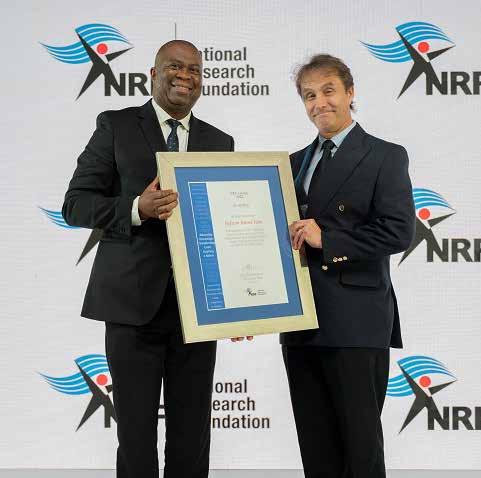
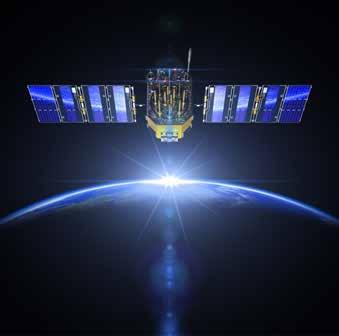
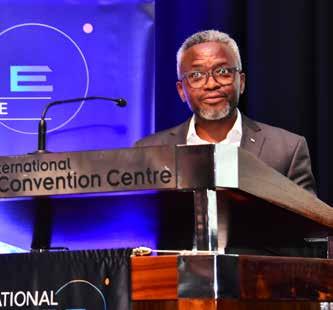

CONTENTS FEATURES 9 Uganda's first female astronomer 11 Dr Phil Mjwara Receives NRF Significant Contribution Award 15 EXPLORING CAREERS IN SPACE SCIENCE 17 ETHIOPIA'S ASCENT: SPACE SCIENCE 22 ASTRONOMY FOR MENTAL HEALTH 26 NATIONAL SPACE CONFERENCE 2023 HIGhLIGHTS 28 ASTRONOMY SCHOOL 32 INDIA'S HISTORIC ACHIEVEMENT 38 GRAVITATIONAL WAVES DETECTED 39 IAU GA2024 40 First female scientist in Mercury Geomorphology and mapping in Tunisia 11 14 20 CONTENTs 26 9 COVER STORY
African Science Stars
team
Editor • Nadine Sims
Graphic designer • Stacey Swartz
Contributing writers
• Lusanda Tamesi

• Duduzile Kubheka
• Lillian Assefa
• Mukosi Fulufhelo
• Nadine Sims
• Tshiamiso Makwela
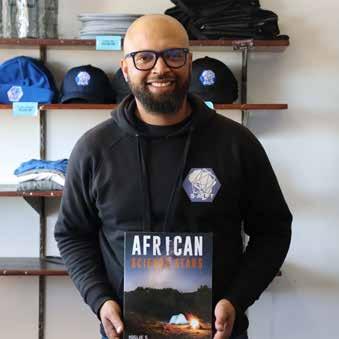
• Dominic Vertue
• Charles Takalana
Chairman • Madambi Rambuda
Subscriptions • info@sciencestars.co.za
Copyright 2023 African Science Stars Pty Ltd. All Rights Reserved. No part of this publication may be reproduced, stored in a retrieval system or transmitted in any form or any means, electronically or mechanically, without prior permission.
African Science Stars is published by Science Stars (Pty) Ltd

African Science Stars is an initiative under the African Astronomical Society and funded by the Department of Science and Innovation.
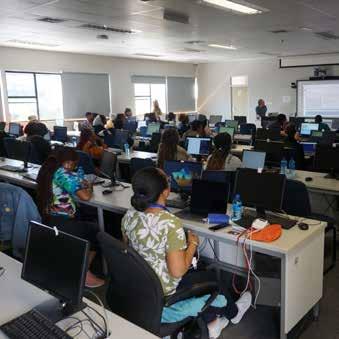

1 Bridgeway, Century City, Cape Town, South Africa, 7441
+27 21 830 5240
info@sciencestars.co.za
www.africansciencestars.com
5 African Science Stars Issue 6 | www.africansciencestars.com 27 40 44 28
REGULARS 6 LETTER FROM THE EDITOR 7 foreword 14 cover story 42 events 44 african science stars on the go 46 careers CONTENTS
LETTER FROM THE EDITOR
A GLIMPSE INTO AFRICA’S SPACE ODYSSEY
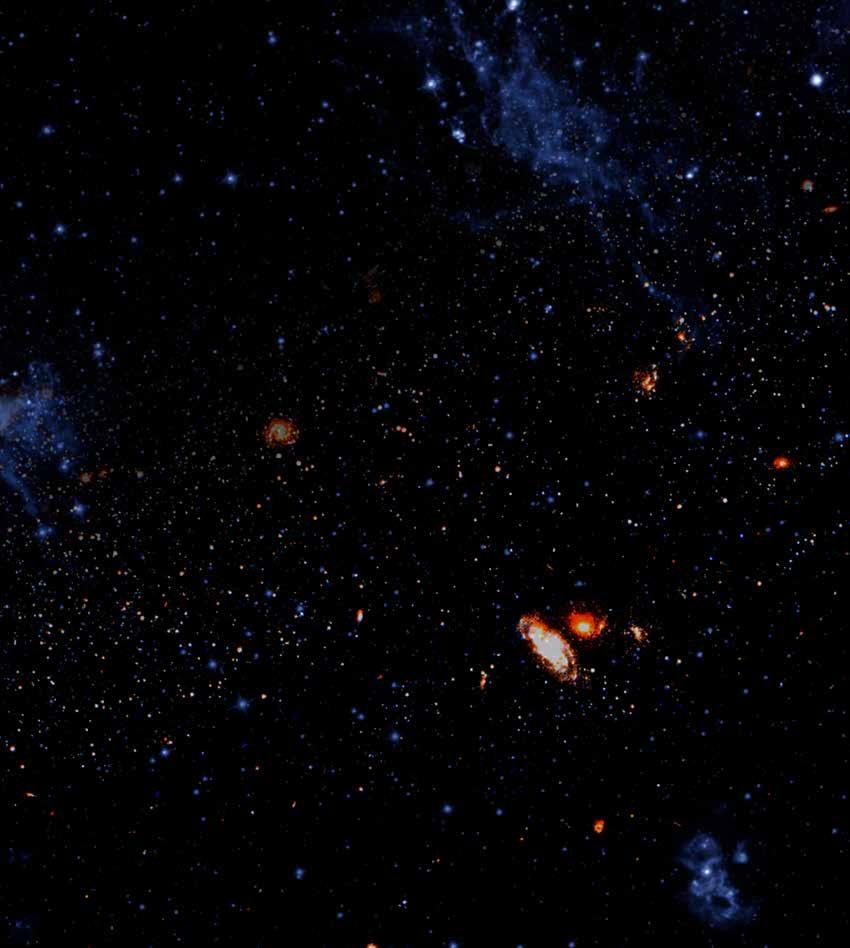
Welcome to this Space Science edition of African Science Stars magazine. As we delve into the celestial realms above our continent, we embark on a fascinating journey through Africa’s space and space science industry. The stories you will discover within these pages are a testament to the vision, innovation and determination of the individuals, organisations and nations that are propelling Africa toward the heavens.
Africa’s exploration of space has reached a pivotal juncture as nations from the northern tip of the continent to its southernmost point engage in a variety of space endeavours. Ethiopia, Nigeria, South Africa and Egypt, among others, have charted ambitious courses into the vast expanse of space, harnessing the power of satellites, telescopes and cutting-edge technology to unlock the secrets of the universe.
In this edition, we shine a spotlight on the key players in the African space landscape, exploring their remarkable achievements and their contributions to space science, technology and education. From the launch of Earth observation satellites to the establishment of stateof-the-art observatories, African nations are leaving an indelible mark on the global space stage.
However, the road to the stars is not without its challenges. Funding constraints, technical expertise and regulatory frameworks pose formidable obstacles that demand innovative solutions. We delve into these challenges, seeking to understand the strategies being employed to overcome them and pave the way for a brighter space future in Africa.
We also explore the myriad applications of space technology on the continent, from revolutionising agriculture and telecommunications to improving disaster management and advancing scientific research. The potential for space technology to uplift African communities, boost economic growth and drive sustainable development is both evident and exciting.
As you read through the articles, I encourage you to consider the profound impact of space science and technology on Africa’s present and future. These stories not only reflect Africa’s aspirations but also its resolve to play a pivotal role in the global space arena. Thank you for joining us on this voyage into the captivating world of African space exploration and space science. We hope you find inspiration in the stories and achievements presented within these pages, and we look forward to witnessing the continued growth and success of Africa in space.
Nadine Sims Editor, African Science Stars
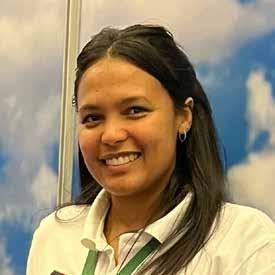
6 African Science Stars Issue 6 | www.africansciencestars.com EDʼS NOTE
UNLOCKING AFRICA’S GIANT EYE: SALT’S DECADE OF IMPACT IN SOUTHERN AFRICA AND BEYOND
Welcome to the Space Science edition of African Science Stars magazine. In the ever-expanding realm of space exploration and discovery, our African continent stands at the threshold of an exciting era. It is with great enthusiasm that we delve into the cosmic wonders and scientific endeavours that define our journey in this edition.
The Southern African Large Telescope (SALT), affectionately known as “Africa’s Giant Eye”, commenced its scientific operations in 2011. Not only has it continued being productive with the number of publications in high-impact journals, but it has also formed a major part of postgraduate students' projects who have successfully graduated.
The versatility of the telescope, through the collection of instruments that it offers, means that SALT users have the opportunity to possess a broad set of skills for analysing and interpreting optical datasets.
Through collaboration with experienced Southern African principal investigators as a starting point, researchers from other African countries can begin using SALT regularly. I encourage postgraduate students to propose for time and build networks at early stages of their careers.
Now is the time for institutions across Africa to harness the potential of "Africa's Giant Eye". As we explore the universe together, we invite you to share in the excitement and wonder of discovery. Our cosmic journey has begun, and SALT lights our path to understanding the cosmos.
These collaborations have the potential for longer-term links and can, in the future, strengthen astronomy development and research in the respective countries. Now is the time for institutions in the continent to make use of SALT!
As you immerse yourself in the pages of this Space Science edition, I invite you to join us in celebrating the boundless possibilities that await us. Together, we embark on a journey of discovery, where the skies are no longer the limit, but merely the beginning of our exploration.
Dr Itumeleng M Monageng
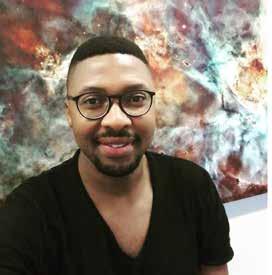 South African Astronomical Observatory | University of Cape Town
South African Astronomical Observatory | University of Cape Town

7 African Science Stars Issue 6 | www.africansciencestars.com
FOREWORD
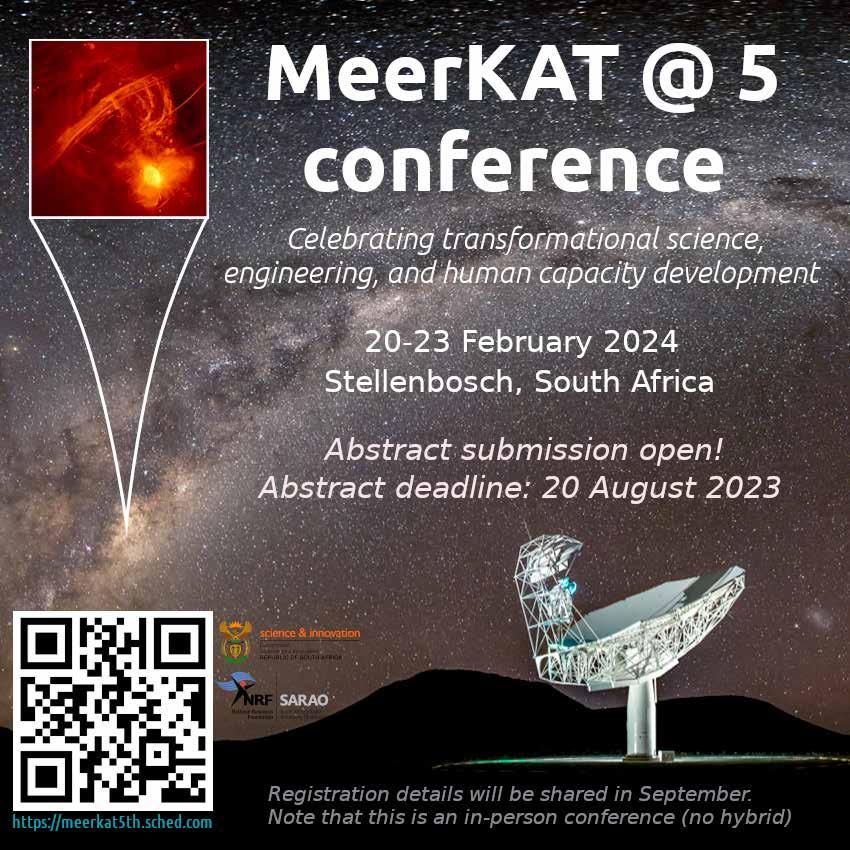
Dr Elizabeth Naluminsa –Uganda’s first female astronomer
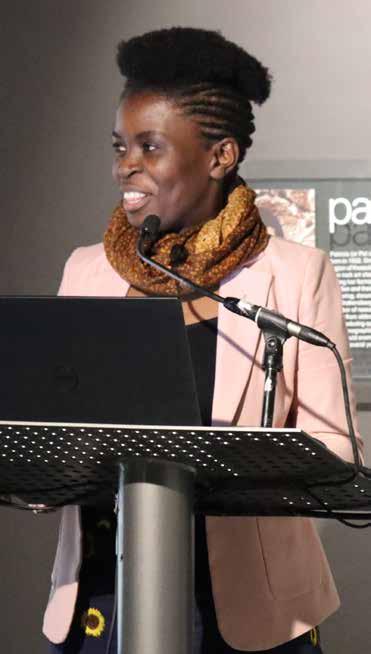
In the realm of astronomy and space science, the night sky has always beckoned to the curious and the dreamers, inspiring them to look beyond our planet’s boundaries and into the infinite cosmos. Dr Elizabeth Naluminsa embodies the spirit of curiosity and exploration that has led her on a remarkable journey from her Ugandan roots to becoming the first female astronomer in her country.
A journey from Uganda to the stars
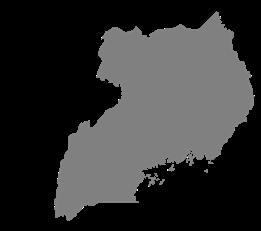
Elizabeth Naluminsa’s journey into the world of astronomy began with a childhood fascination for the moon landing. She vividly recalls a story in her English textbook about Neil Armstrong and the Apollo 11 mission. The captivating image of humans setting foot on the moon ignited her imagination. While she recalls folklore and tales of the moon, the reallife account of astronauts landing on the lunar surface was a revelation that left an indelible mark on her young mind.
“Back then we had lots of folktales, and one of them was about a lady and her child stuck on the moon,” she reminisces. “Of course, by a certain age, one would have figured out it was mostly a made-up story, but to come across this account of humans actually going to the moon was on a whole other level. It was quite fascinating to me, and I began to fancy a career in the stars.”
As she progressed through her education, Dr Naluminsa’s interest in astronomy was solidified. In high school, she encountered a physics teacher who made the subject come alive, further fueling her passion for the cosmos. It was during her undergraduate studies in physics at Mbarara University of Science and Technology that she discovered the
9 African Science Stars Issue 5 | www.africansciencestars.com UGANDA
possibility of pursuing astronomy at the postgraduate level in South Africa.
Uganda's first female astronomer
Becoming Uganda’s first female astronomer was a revelation that took Dr Naluminsa by surprise. She shares, “I actually had no idea until a few weeks after my graduation. I had a meeting with one of the female astronomers that I really look up to, and when she mentioned the fact, that’s when it dawned on me. It was both a surprise and a shock.”
For Dr Naluminsa, her journey into astronomy had always been about pursuing her passion and realising her dreams. It was only after the revelation of her unique status that she recognised the responsibility it carried. As the first female astronomer in Uganda, she now sees the importance of inspiring young girls and encouraging them to explore careers in the STEM (Science, Technology, Engineering and Mathematics) fields.
“To get more Ugandan girls interested in the field of astronomy, and even more generally in the STEM fields, is a responsibility I gladly embrace,” says Dr Naluminsa. “Now there’s a generation of Ugandan kids that have female astronomers to look up to (plus access to the internet), and we will make this count.”
Career highlights and inspirations
Throughout her career, Dr Naluminsa has achieved numerous highlights that have shaped her journey in astronomy. Three moments stand out as particularly significant:
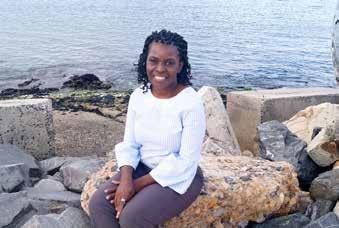
Her admission to the National Astrophysics and Space Science Programme (NASSP) at the University of Cape Town was a turning point. “Every day that I woke up to go to the university to study astronomy felt like a dream come true,” she shares. It was during her time at NASSP that she began to fully live her dream of becoming an astronomer.
Dr Naluminsa describes her experience working at the South African Large Telescope (SALT) as “a whole other level of amazing.” SALT had always been a distant aspiration, she explained. “Every day I walked into work with lightness of foot, sometimes I’d literally run up the stairs just for sheer joy.”
Her most recent highlight is her permanent position at Makerere University in Uganda. Teaching at her alma mater allows her to share her passion for astronomy and science with the next generation. “To walk into work every morning with gladness in my heart and to see the lives of students take shape in our hands as their teachers, it’s a blessing,” she says.
Encouraging women in astronomy
As a woman who has broken barriers in the male-dominated field of astronomy, Dr Naluminsa emphasises the importance of creating opportunities and providing mentorship to aspiring female astronomers. She believes that fostering early interest in STEM subjects among young girls is crucial.
“For a young girl to know that she, too, has the capacity for science just as much as her male colleagues is a freeing mental shift, which will help her break down many other barriers even elsewhere in life,” she explains.
Dr Naluminsa encourages women to pursue careers in astronomy and STEM fields, emphasising that astronomy is a beautiful and captivating field that allows individuals to explore the mysteries of the universe. Her own journey from Uganda to the stars serves as an inspiring example for aspiring astronomers, particularly women, to chase their dreams and reach for the cosmos.
Dr Naluminsa’s story is a testament to the power of curiosity, determination and a passion for exploring the unknown. As Uganda’s first female astronomer, she continues to inspire the next generation of scientists and astronomers, helping to bridge the gender gap in STEM fields and fostering a brighter future for science in Uganda and beyond.
10 African Science Stars Issue 6 | www.africansciencestars.com UGANDA
"Every day that I woke up to go to the university to study astronomy felt like a dream come true”
In a momentous occasion at the 2023 National Research Foundation (NRF) Awards ceremony held on 31 August in Durban, the NRF honoured Dr Phil Mjwara, Director General of the Department Science and Innovation, with the prestigious Significant Contribution Award.

The NRF Awards are an annual celebration of excellence, recognising outstanding achievements and internationally competitive work by individuals and teams in the field of science and technology. Driven by the goal of fostering a culture of excellence and advancing South Africa’s scientific knowledge and technological innovation, these awards are a testament to the nation’s dedication to progress and innovation.
This year’s awards bore a special significance, being held under the theme “Celebrating 20 years of the Square Kilometre Array (SKA) Project in South Africa.” The SKA project represents a landmark in global scientific collaboration and discovery, and South Africa’s pivotal role in this venture added a unique dimension to the awards ceremony. The SKA, once completed, will be the largest and most sensitive radio telescope in the world.
Dr Phil Mjwara was bestowed with the NRF Significant Contribution Award in recognition of his remarkable role in South Africa’s involvement in the SKA project, spanning from its inception to the present day. His unwavering support and belief in South Africa’s capacity to host this colossal and scientifically significant radio telescope array played a pivotal role in the country’s successful bid.
Beyond his contributions to the project itself, Dr Mjwara has been instrumental in realising the spinoff benefits that the SKA has brought to South Africa. These include job opportunities in construction and eco-tourism, skill development and training, and advancements in education from basic to tertiary levels.
The Minister of Higher Education, Science and Innovation, Dr Blade Nzimande, lauded local scientists for their exceptional contributions, particularly during the challenging times of the Covid-19 pandemic. He stressed the importance of expanding mentorships, training opportunities and capacity building at research institutions, as well as encouraging more learners to pursue STEM subjects.
He also commended the NRF for its impact in transforming South Africa’s academic landscape, emphasising the foundation’s support for historically disadvantaged groups. Notably, 81% of the students funded by the NRF are black, and the researchers it supports include 59% women and 50% black women.
Minister Nzimande underscored the vital role played by NRF Awards in maintaining high standards of research excellence in South Africa. These awards serve as a testament to the value of knowledge creation by South African scientists and institutions. Through their outstanding work, they not only advance knowledge but also change lives and inspire the nation.
In his closing remarks, Dr Fulufhelo Nelwamondo, NRF CEO, acknowledged the significance of the contributions made by award recipients and encouraged them to continue their extraordinary work. He emphasised the importance of science in improving lives and creating a sustainable future for all members of society.
Dr Phil Mjwara's receipt of the NRF Significant Contribution Award at the 2023 NRF Awards ceremony is a testament to the vital role he has played in South Africa's scientific journey, particularly through the SKA project.
The NRF Awards, with their focus on excellence, diversity and transformation, stand as a symbol of South Africa’s commitment to advancing knowledge, changing lives and inspiring the nation through scientific endeavors. As South Africa continues to make strides in the world of science and technology, these awards serve as a beacon of recognition and motivation for the nation’s scientific community.
11 African Science Stars Issue 6 | www.africansciencestars.com AWARDS
DR. PHIL MJWARA RECEIVES NRF SIGNIFICANT CONTRIBUTION AWARD
SAVE THE DATE
11—12 November 2023
Addis Ababa, Ethiopia
AFRICAN PLANETARIUM ASSOCIATION



BIANNUAL WORKSHOP
in conjunction with the IAU Symposium 386:
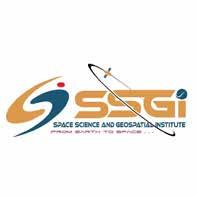
Dark Sky and Astronomical Heritage in Boosting Astrotourism
THEMES WILL INCLUDE:

• Using planetaria for education and promoting science

• Planetaria as a tool for Astrotourism
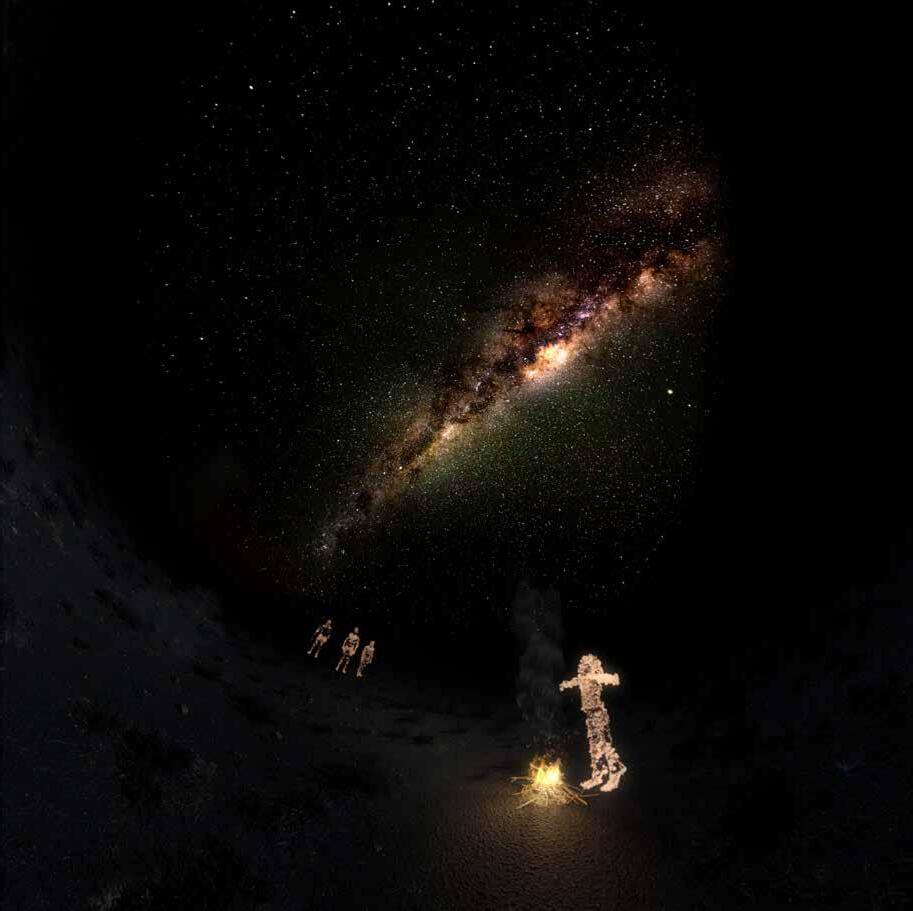
• Building and maintaining a sustainable planetarium
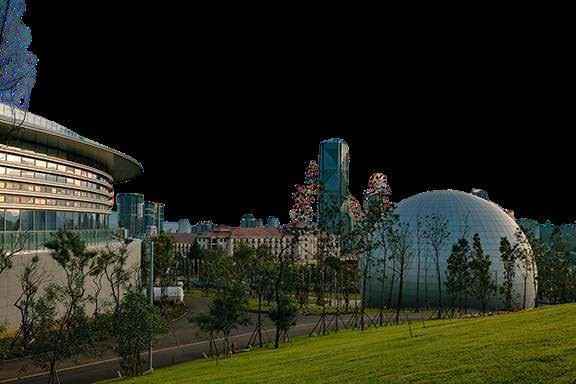
• APA: next steps and getting involved
• Addressing planetarium challenges in Africa

THE GROWING SPACE SCIENCE INDUSTRY IN AFRICA
Africa, often overlooked in discussions about space exploration and technology, is making significant strides in the space and space science industry. While historically, space endeavours have been dominated by major global players like NASA, ESA, Roscosmos and private companies like SpaceX, African nations are increasingly recognising the potential of space technology for scientific research, economic development and national security. Below, we will delve into the emerging space industry in Africa, exploring its achievements, challenges and the promising future that lies ahead.
The African space landscape: A brief overview
Africa’s journey into space began modestly in the 1960s with the establishment of space agencies and research centres across the continent. The first African nation to venture into space was Egypt – they sent their first satellite into space in 1998. Since then, several other African nations have joined the space race, establishing their own space agencies and developing satellite technology.
Key players in African space
South Africa: The South African National Space Agency (SANSA) has been a pioneer in space science and technology on the continent. South Africa has launched several satellites, including SumbandilaSat, and is known for its capabilities in satellite manufacturing and ground control operations. SANSA also recently launched their 24/7 Space Weather Centre, monitoring the sun and its activity.
Nigeria: The National Space Research and Development Agency (NASRDA) is Nigeria’s space agency. Nigeria has launched multiple satellites, such as NigeriaSat-1 and NigeriaSat-2, which have applications in agriculture, disaster management and communications.
Egypt: Egypt’s space agency, the Egyptian Space Agency (EgSA), has been active in space research and development. They have launched their own Earth observation satellites, like EgyptSat-1 and EgyptSat-2.
Kenya: In 2009 the National Space Secretariat was established and by 2017 the Kenya Space Agency (KSA) was established as its successor, with the main aim to promote space science and technology in the country. Kenya launched its first satellite, 1KUNS-PF, in 2018.
Ethiopia: Ethiopia has been actively pursuing space exploration and technology development. The Ethiopian Space Science Society has been conducting research in astronomy and space science.
Space applications in Africa
The applications of space technology in Africa are wide-ranging and have the potential to drive economic growth and improve the quality of life. Some of the key areas where space science and technology are making an impact include:
Agriculture: Satellites are used for monitoring crop health, soil moisture levels and weather patterns, helping farmers make informed decisions to improve agricultural productivity.
Telecommunications: Space-based communication systems are crucial for extending internet access and improving connectivity in remote and underserved areas.
Disaster management: Space-based technology is instrumental in monitoring natural disasters such as droughts, floods and wildfires. Timely information helps authorities respond effectively to mitigate the impact.
Climate change: Earth observation satellites provide essential data for monitoring climate change, tracking deforestation and managing natural resources.
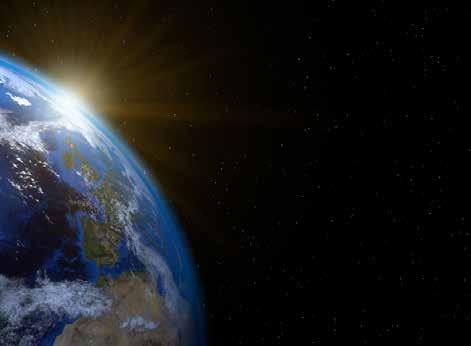
13 African Science Stars Issue 6 | www.africansciencestars.com
SPACE SCIENCE
Education and research: Space science and astronomy provide unique opportunities for scientific research and inspire the next generation of African scientists and engineers.
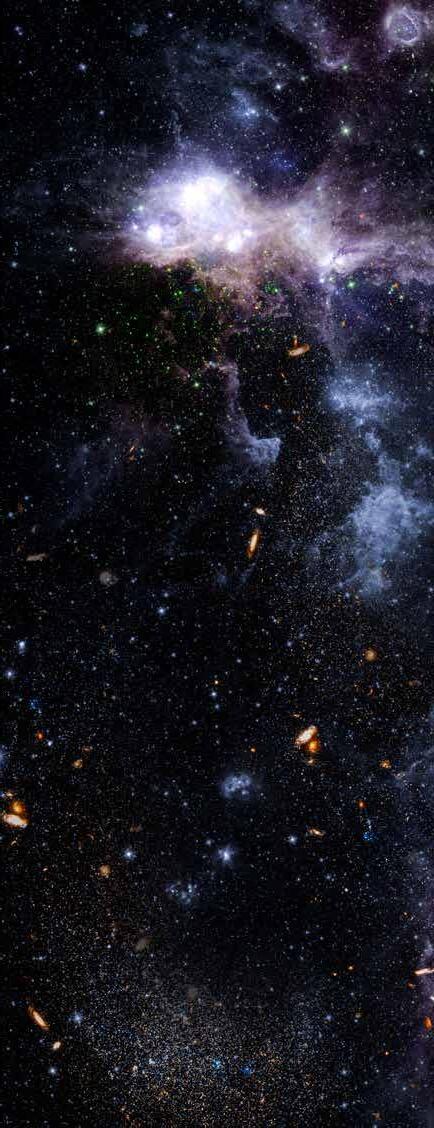
Challenges facing the African space industry
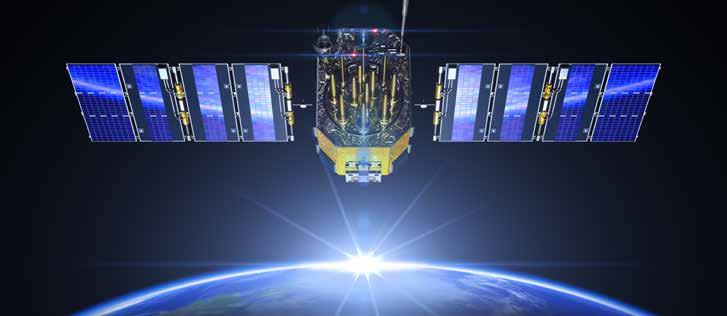
While the African space industry shows promise, it also faces several challenges:
Funding constraints: Developing and launching satellites is expensive, and many African nations struggle to secure the necessary funding. Limited budgets hinder the growth of space programs.
Technical expertise: Developing a skilled workforce in aerospace engineering and space science is a long-term challenge. Many African nations must rely on international expertise and collaborations.
Infrastructure: Building and maintaining the necessary infrastructure for space missions, including ground control stations and launch facilities, is a significant undertaking.
Regulatory frameworks: often lack comprehensive legal and regulatory frameworks for space activities, which can create uncertainties for investors and partners.
Competition: The global space industry is highly competitive, with established players and emerging nations vying for a share of the market. African countries must find their niche to compete effectively.
The future of African space exploration
Despite these challenges, Africa industry is poised for growth and innovation. Below we mention some key trends and opportunities for the future.
Expanding access to space is vital. As launch costs decrease and technology becomes more accessible, African nations have a growing opportunity to develop and launch their satellites.
International collaboration with established space agencies and private companies can accelerate technological advancements and provide valuable
14 African Science Stars Issue 6 | www.africansciencestars.com
SPACE SCIENCE
ARE YOU A STARRY-EYED DREAMER
Exploring careers in Space Science: Your cosmic pathway
By: Mukosi Fulufhelo
FIND YOURSELF GAZING UP AT THE
Astronomer could be your chance to turn that passion into a profession. Astronomers study celestial objects, stars to deciphering the birth and death of stars, this
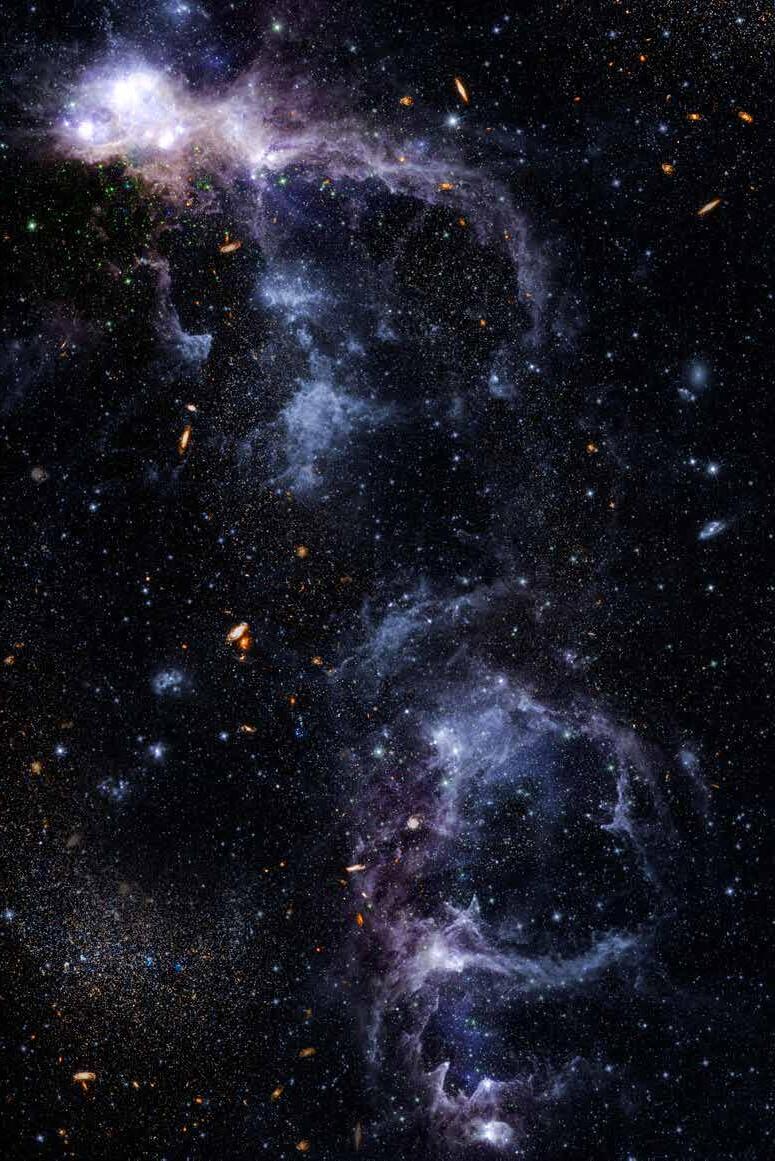 s engineering
s engineering
re
Planetary Scientist: Exploring worlds beyond our own
Have you ever wondered what secrets planets, moons and asteroids hold? Planetary Scientists dive deep into the study of these celestial bodies. They analyse data from space missions and telescopes to unravel the geology, atmospheres and potential for life on other planets. If the idea of exploring the diverse landscapes of our solar system and beyond excites you, Planetary Science might be within your orbit.
Space Mission Specialist: Hands-on cosmic adventures
Are you someone who thrives on adventure and exploration?
Becoming a Space Mission Specialist could be the ultimate cosmic journey for you. Mission Specialists are astronauts who participate in space missions, conduct experiments in microgravity and even perform spacewalks. If the idea of floating in the void while conducting ground-breaking research ignites your imagination, this could be your zero-gravity destiny.
Space Communications Specialist: Connecting the cosmos
Do you possess a flair for both technology and communication? Space Communications Specialists play a crucial role in transmitting data between Earth and spacecraft. They ensure that signals from space missions, satellites and rovers reach us with clarity. Whether it’s relaying images from Mars rovers or maintaining communication with astronauts on the International Space Station, these specialists are the cosmic messengers.
Space Tourism Manager: Turning dreams into reality
Are you excited about the prospect of commercial space travel?
As the space tourism industry takes off, Space Tourism Managers are the ones orchestrating these out-of-world experiences. From curating space travel packages to ensuring the safety and comfort of passengers, this role combines the thrill of exploration with the intricacies of hospitality.
Astrobiologist: Seeking life beyond our planet
Are you captivated by the question of whether life exists beyond Earth? Astrobiologists study the potential for life elsewhere in the universe. They investigate extreme environments on Earth to understand where life could thrive in the cosmos and analyse the potential habitability of exoplanets. If the intersection of biology, chemistry and space intrigues you, Astrobiology might be your cosmic calling.
Space Educator: Inspiring the next generation
For those who are passionate about both space and education, a career as a Space Educator can be immensely rewarding. Space Educators design and deliver educational programmes, workshops and outreach activities that inspire young minds to explore the universe and consider careers in space sciences.
Aerospace Medicine Specialist: Ensuring astronaut health
The health and well-being of astronauts are crucial for successful space missions. Aerospace Medicine Specialists work on understanding the physiological effects of space travel on the human body and developing strategies to mitigate potential health risks. Their expertise ensures that astronauts remain healthy and fit during extended missions.
Space Lawyer: Navigating the legal frontiers
As space exploration and commercial activities expand, space law becomes increasingly important. Space Lawyers specialise in international agreements, regulatory frameworks and legal issues related to space activities. Their role ensures that space exploration and utilisation adhere to international laws and treaties.
Charting your course to the stars
From gazing at the night sky to charting your course in space science, the universe is brimming with opportunities for discovery and wonder. Whether you’re fascinated by the mysteries of distant galaxies, the intricacies of planetary systems, the challenges of engineering for space travel, or the quest for extraterrestrial life, there’s a place for you in the universe of space careers.
These diverse roles demonstrate that Space Sciences encompass not only scientific research but also engineering, technology, law, education, and more. As humanity continues to push the boundaries of space exploration, the need for talented individuals from various disciplines will only grow, making now the perfect time to consider a career that shoots for the stars.
So, dear cosmic explorers, the universe awaits your passion, curiosity and dedication. The stars are calling – will you answer?
Embark on your journey and, who knows, you might just be the one to unravel the next cosmic mystery.
16 African Science Stars Issue 6 | www.africansciencestars.com CAREERS
ETHIOPIA'S ASCENT: THE EMERGING SPACE AND SPACE SCIENCE INDUSTRY
Ethiopia, a land of rich history and diverse cultures, is making strides in a new frontier – space and space science. Over the past few decades, Ethiopia has been carving its niche in the global space arena, aiming to harness the potential of space technology for scientific research, economic development and national security. Below, we will explore Ethiopia’s burgeoning space and space science industry, its notable achievements and its promising future.
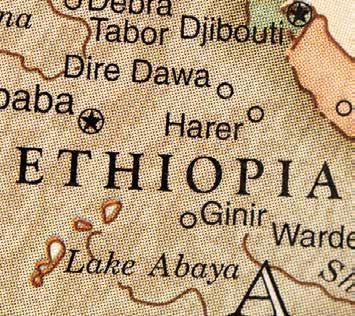
Key players in Ethiopian space exploration
Ethiopian Space Science Society (ESSS): ESSS is a non-profit organisation dedicated to advancing space science and technology education and research in Ethiopia. It serves as a driving force behind the country’s space aspirations, conducting outreach programs and supporting space education initiatives.
Entoto Observatory and Research Centre: Located in the Entoto Mountains near Addis Ababa, this observatory is equipped with advanced telescopes for astronomical research and observations. It plays a vital role in Ethiopia’s space science endeavours.
Space Science and Geospatial Institute (SSGI): Their mission is to ensure international competitive research, timely and reliable information supply, technological development, social and economic development in the field of human resources in the field of technology and industrial transfer.
Achievements
The Ethiopian Space Science Society’s Educational Programmes has been instrumental in promoting space science education in Ethiopian schools. It conducts workshops, outreach programs and competitions to spark interest in space-related fields among students.
The Entoto Observatory and Research Center have made significant contributions to astronomy and space science. It hosts research activities, public outreach events, and has collaborated with international institutions.
Ethiopia successfully launched its first satellite, ETRSS-1 (Ethiopian Remote Sensing Satellite-1), in December 2019. The satellite primarily focuses on Earth observation, supporting agricultural monitoring, environmental management and disaster response applications. Building on the success of ETRSS-1 and leveraging space technology for economic purposes, such as agriculture, telecommunications and mineral exploration, can also drive economic growth in the country.
Ethiopia has also forged collaborations and partnerships with various countries, including China and Russia, to enhance its space capabilities. These partnerships involve knowledge transfer, training and satellite development.
Ethiopia’s space and space science industry is on an exciting trajectory, driven by the determination to explore the cosmos and reap the benefits of space technology. As Ethiopia continues to invest in space science and collaborate with international partners, it has the potential to become a significant player in the global space arena, especially in Africa.
The nation’s rich history and cultural diversity are now accompanied by a commitment to exploring the universe, making Ethiopia’s ascent into space a compelling journey to watch. With strategic planning and a focus on education and research, Ethiopia is poised to reach new heights in space exploration and make valuable contributions to the scientific and economic growth of the nation.
17 African Science Stars Issue 6 | www.africansciencestars.com
ETHIOPIA
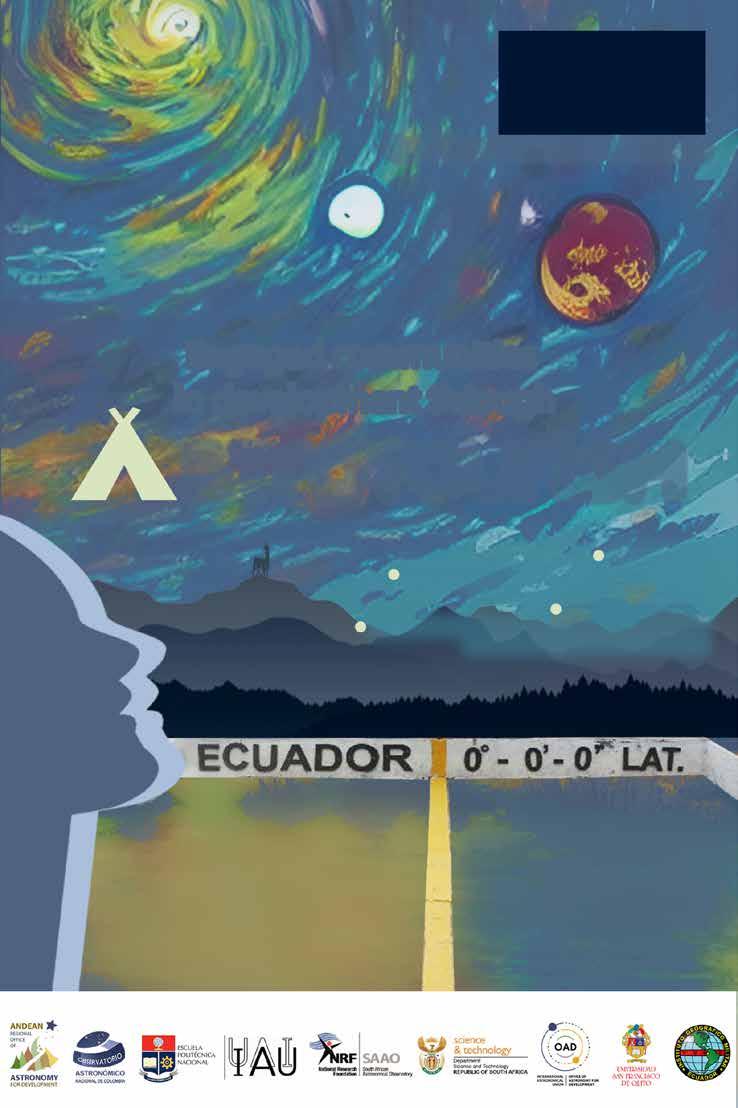




NIGERIAN SPACE RESEARCH AND DEVELOPMENT NASRDA
The Nigerian Space Research and Development Agency (NASRDA) s ambition to harness the potential of space technology for the betterment of its citizens and the advancement of science and innovation on a global scale.
Founded in 1999, NASRDA has rapidly evolved into a key player in the international space community, using space technology to address critical challenges while inspiring the nation’s youth to

s origins trace back to the late 1990s when Nigeria recognised the significance of space technology for national development. The Nigerian government established NASRDA in 1999 to consolidate efforts in space research and development. The agency’s primary mandate is to oversee the nation’s space activities, promote the peaceful use of outer space, and facilitate socio-economic growth through space technology applications.
Space programs and achievements

s pursuit of space exploration has led to a series of remarkable achievements, showcasing s growing prowess in this field. One of its most notable accomplishments is the development and launch of Nigeria’s first satellite, NigeriaSat-1, in 2003. This marked a historic moment, as Nigeria became the first African nation to design, build and launch a satellite into orbit.
Subsequent to NigeriaSat-1, NASRDA continued its endeavours, successfully launching a series of satellites under the Nigerian Communication Satellite System (NIGCOMSAT) programme. These
19 African Science Stars Issue 6 | www.africansciencestars.com NIGERIA
satellites have enhanced communication infrastructure, provided valuable data for disaster management and improved navigation systems, all while reducing the nation’s reliance on foreign satellite services.
Space applications for development
NASRDA’s vision extends beyond scientific exploration; it encompasses utilising space technology to address practical challenges in Nigeria. The agency’s Earth observation satellites have been instrumental in monitoring natural resources, tracking deforestation, managing water resources and aiding in agricultural planning. These applications have contributed to informed decision-making, sustainable resource management and disaster response.
The Nigerian Space Agency has also played a pivotal role in disaster management and mitigation. In 2012, the NigeriaSat-2 and NigeriaSat-X satellites captured vital imagery during the devastating floods in Nigeria, supporting emergency response and recovery efforts.
Capacity building and STEM education
NASRDA recognises that the future of space exploration lies in the hands of its youth. The agency has taken significant steps to inspire and educate the next generation through its STEM (Science, Technology, Engineering and Mathematics) education initiatives. Programmes like the National Space Research and Development School (NSRDS) and the Nigerian Space Science Olympiad (NSSO) have nurtured young talents and fostered interest in space science and technology among Nigerian students.
International collaborations and global impact
NASRDA’s achievements have not gone unnoticed on the international stage. The agency has fostered collaborations with various international space agencies and organisations, contributing to joint research projects, technology transfers and capacity-building initiatives. These partnerships have facilitated knowledge exchange, technological advancements and the further integration of Nigeria into the global space community.
Future prospects and beyond
As NASRDA looks to the future, its aspirations remain high. The agency aims to diversify its satellite offerings, enhance space technology capabilities and expand its applications to address emerging challenges. With plans to launch more advanced satellites for disaster management, climate monitoring and navigation systems, NASRDA is positioning itself as a regional leader in space technology and innovation.
In conclusion, NASRDA is a testament to Nigeria’s determination to embrace space technology for the betterment of its people and the advancement of human knowledge. From its humble beginnings to its notable achievements in satellite technology and space applications, NASRDA stands as a beacon of inspiration for African nations and aspiring space faring countries around the world. As NASRDA continues its journey among the stars, its impact on Nigeria’s socio-economic development and its contributions to global space exploration is poised to grow even more significantly in the years to come.
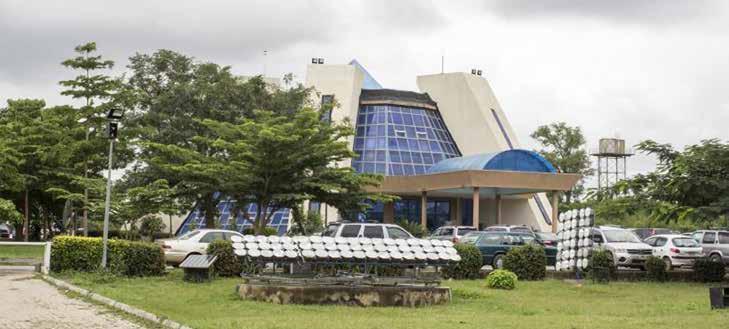
20 African Science Stars Issue 6 | www.africansciencestars.com NIGERIA
NASRDA-building
NURTURING INNOVATION: THE 2023 NASA INTERNATIONAL SPACE APPS CHALLENGE
In a world marked by technological advancements and global collaboration, the annual NASA International Space Apps Challenge stands out as a beacon of innovation and creativity. As we step into the year 2023, space enthusiasts, coders, engineers and problem-solvers worldwide eagerly anticipate this extraordinary event.
The Space Apps Challenge, organised by NASA, continues to captivate the hearts and minds of individuals passionate about space exploration, Earth science and tackling the challenges facing our planet.
This year’s theme is “Explore Open Science Together.” NASA will be partnering with Space Agencies from across the world including: the Australian Space Agency, Brazilian Space Agency, Canadian Space Agency, European Space Agency, Indian Space Research Organization, Italian Space Agency, Japan Aerospace
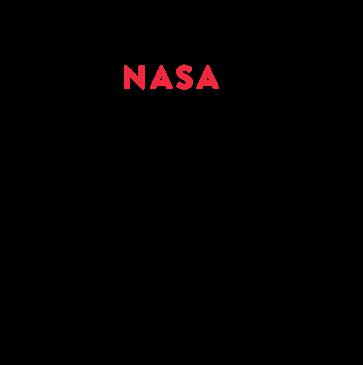
Exploration Agency, Mexican Space Agency, National Space Activities Commission of Argentina, National Space Science Agency of Bahrain, Paraguayan Space Agency, South African National Space Agency and the Turkish Space Agency.
The NASA International Space Apps Challenge, now in its 11th year, has evolved into a global phenomenon. Every year, thousands of participants from diverse backgrounds and countries come together for a weekend of intense collaboration, brainstorming and coding. This event transcends geographic boundaries as teams gather in person at local events or participate virtually, forming a global network of innovators.
During the Space Apps Challenge, teams work tirelessly to develop innovative solutions to challenges. These solutions often incorporate data from NASA’s vast archives, satellite observations and various open-source tools. Participants have access to a treasure trove of resources, including data sets, APIs and expert guidance from NASA scientists and engineers.
What sets the Space Apps Challenge apart is its focus on practical applications. The solutions produced during the event are not just theoretical concepts but often evolve into real-world projects and products with the potential for significant impact.
As we look ahead to the 2023 NASA International Space Apps Challenge, the excitement is palpable. The challenges presented this year promise to be both intriguing and impactful, pushing participants to think creatively and develop solutions that contribute to NASA’s mission and address global challenges.
The event’s continued success and growth are a testament to the enduring appeal of space exploration and the power of collaborative innovation. The 2023 Space Apps Challenge is not just an opportunity for participants to showcase their skills and passion; it is a celebration of human curiosity and the unending quest to explore the cosmos.
This event is more than just a hackathon or a coding competition. It is a global gathering of like-minded individuals driven by their shared love for space and a commitment to making a positive impact on our planet and beyond.
The two-day hackathon event will take place from 7–8 October 2023. To register, or to find out more information, visit spaceappschallenge.org
21 African Science Stars Issue 6 | www.africansciencestars.com
NASA
Image from: Freepix
OFFICE OF ASTRONOMY FOR DEVELOPMENT (OAD): ASTRONOMY FOR MENTAL HEALTH
The International Astronomical Union’s Office of Astronomy for Development (OAD) aims to use the resources and skills of astronomy to promote sustainable development worldwide.
Astronomy is a multidisciplinary topic with strong links to culture and heritage, making it suitable for addressing a wide range of societal issues. Examples include the use of astronomy topics to improve educational outcomes, teaching critical thinking and skills such as coding, and providing opportunities for socioeconomic growth in rural areas through astro-tourism.
In addition to having clear benefits for educational outcomes, astronomy can also improve mental health and well-being.

The exciting field of astronomy can induce awe and grab attention. An astronomy-oriented activity, such as stargazing, has the potential to change perspective and reframe one’s problems. It also provides opportunities to engage in a shared activity and thereby experience social integration, connectedness
and belonging. It invokes curiosity and leads to new questions, interests and ideas. Through careful design and by working in conjunction with mental health experts, it is possible to introduce an astronomy-based activity in order to promote mental health and well-being.
The Astronomy for Mental Health project aims to explore how the inspirational and cultural aspects of astronomy can help improve the mental well-being of society.
Research has shown that stargazing could be considered as a “Dark Nature” activity in that it does not just take place in the dark but that those involved interact with the nocturnal environment. As such, stargazing offers benefits similar to those experienced by people taking part in daytime activities within natural environments such hiking. “Dark Nature” activities allow us to move away from the urban lights, disconnect from our devices, experience a break from the constant stimulation we are surrounded by, and gaze at a clear night sky.
Unfortunately, not all cities have easy access to dark skies. Alternative activities include using astronomy apps or visiting planetariums or science centres for virtual starry experiences. To contribute, the Astronomy for Mental Health project is currently developing tools and activities that will improve mental health and well-being with the intention of being accessible for all people regardless of location.
One resource being developed is aimed at supporting the mental well-being of postgraduate students. The importance of mental health in postgraduate students cannot be overstated. The intense academic pressure and competition can lead to burnout, anxiety and other mental health issues. Prioritising mental well-being fosters resilience, improves productivity and ensures a positive academic environment.
Another project is ‘Astro Yoga’ which promotes a holistic approach to well-being through stargazing and guided yoga by connecting the beauty of the night sky with personal reflection.
If you have ideas or activities that you think could be used to improve well-being, if you want to co-design activities, or just want to find out more get in touch via email at mentalhealth@astro4dev.org or visit astro4dev.org
The resources are available at: astro4dev.org/astronomy-for-mental-health-resources/
22 African Science Stars Issue 6 | www.africansciencestars.com MENTAL HEALTH

NkosimappingtheseafloorinFalseBay

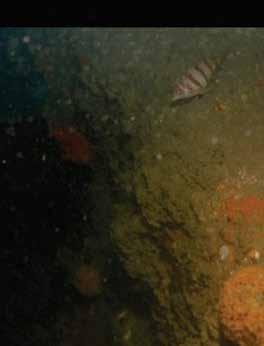
MARINE GEOLOGY AT THE COUNCIL FOR GEOSCIENCE: HOW WE ARE HELPING TO BOOST THE BLUE ECONOMY
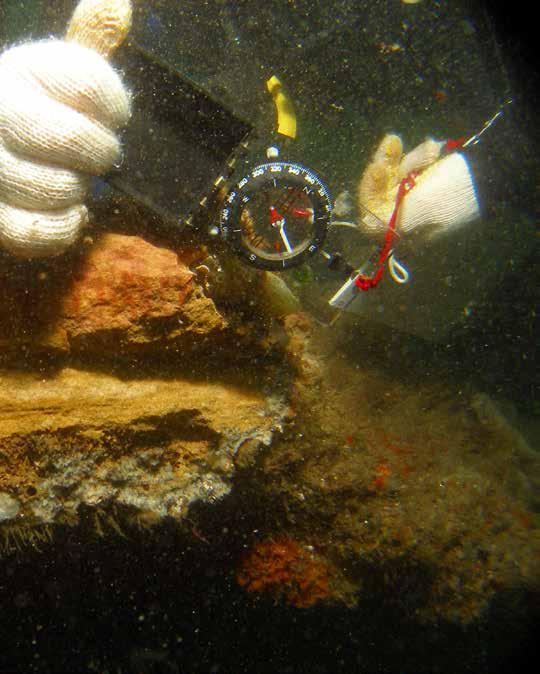

We live on the “blue planet” and we have learned more about the sea in the past half century than during all of preceding history – from seismic activity and tectonic plate shifts to the existence of hydrothermal vents and the abundant diversity of life forms. Marine geology is a subdiscipline of geology and focusses on areas affected by our oceans, including the deep ocean floor, the shallower slopes and shelves that surround the continents and coastal areas like beaches and estuaries. The underwater component of this area of research started to emerge in the years following the second world war when sonar technologies, with principles borrowed from bats and marine mammals, were applied to “see” through low-visibility areas and search for sea mines and submarines in water.
Globally, vast areas of the ocean floor still remain unchartered to any level of detail. Most of what we know about the topography of the ocean floor was pieced together from gravity data gathered by satellites. To date, only small areas of the seafloor (just over 20% in 2023) have been mapped in high resolution using sonar. The spatial resolution of the gravity grid is about 5km2 and, by comparison,
Measuringdipandstrikeofrockdeposits25munderthewater
Discoveringa
including South Africa, are actively mapping the seafloor in their Exclusive Economic Zones through a programmatic approach. The Council for Geoscience is leading this initiative in South Africa. Ocean research is an area where discoveries can still be made, and each time we work on a new patch of seafloor, we bring to light features and structures
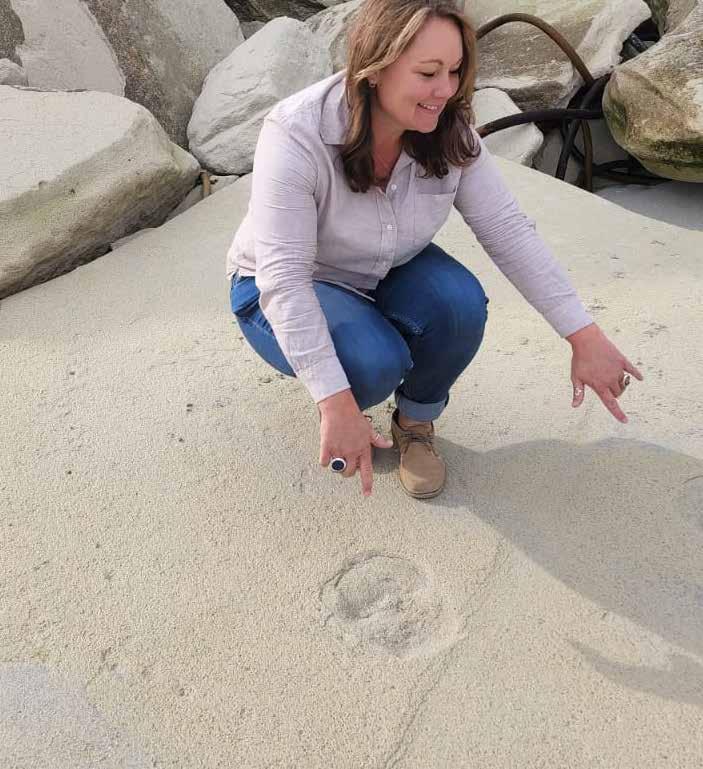

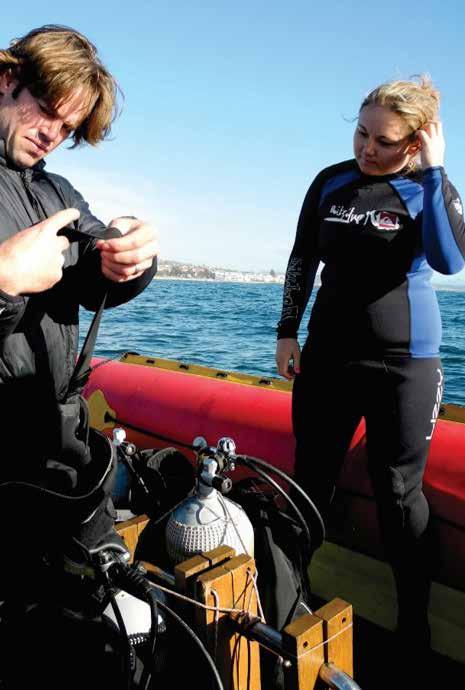
to society from this work include providing baseline data of the past to better anticipate future climate and environmental change, locating offshore strategic mineral resources and commodities, conducting earthquake and tsunami hazard assessments and characterising seafloor habitats and ecosystems.
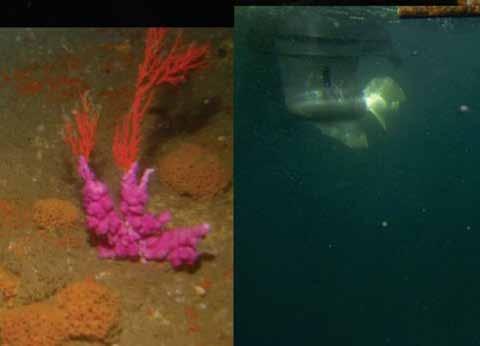
~100-thousand-year-oldextinctbuffalotrackwaycemented
NATIONAL SPACE CONFERENCE 2023 HIGHLIGHTS
From 30 August to 1 September 2023, the inaugural National Space Conference brought together scientists, researchers, policymakers and space enthusiasts from around South Africa and the world, to discuss and celebrate the latest developments in space science, technology and exploration.
Hosted by the South African National Space Agency (SANSA) in collaboration with partners, including the Department of Science and Innovation (DSI), the National Earth Observations and Space Secretariat (NEOSS), the South African Airforce and the CSIR, this conference showcased South Africa’s growing role in the global space community and its commitment to advancing space research and innovation.
The 2023 conference took place at the CSIR International Convention Centre in Pretoria and was a significant event that marked South Africa’s growing presence in the space sector. With a theme of “Space for Inclusive Growth” the conference aimed to foster collaboration, knowledge sharing and innovation in spacerelated fields.
Over the course of three days, attendees had the opportunity to participate in various presentations, panel discussions, and technical sessions covering a wide range of space topics. Participants could also explore the exhibition area, which saw 21 exhibitors take part and showcase their entities.
The conference opening ceremony featured a lineup of renowned keynote speakers who shared their insights and experiences in the space industry. These speakers included Mr Humbulani Mudau (CEO of SANSA), Lieutenant General Wiseman Simo Mbambo (Chief of the Airforce) and Dr Phil Mjwara (Director General of the DSI).
During the opening ceremony, Dr Mjwara unveiled a small-scale model of a rocket called the SAFFIRE. The acronym stands for the South African First Integrated Rocket Engine and was developed by the University of KwaZulu-Natal Aerospace Systems Research Institute. The aim of SAFFIRE is to be used as a small satellite launch vehicle.
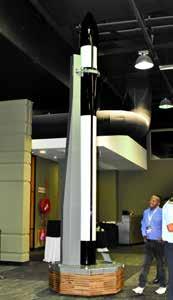
One of the central focuses of the conference was space science and research. Scientists presented their latest findings on topics such as Earth Observation, Remote Sensing and Outreach activities.
The conference also covered cutting-edge space technology and innovation. Presentations on satellite technology, space applications, harnessing AI and machine learning provided attendees with a glimpse into the future of space endeavours.
In his opening address, Mudau said, “We must continue enhancing our capability to produce and manage Earth observations. This will support us in its efforts to increase food security, implement water management plans, and lessen the impact of climate change and solve many other challenges for the society. We must also keep making data available for better decision-making.”
The National Space Conference 2023 was a resounding success, showcasing South Africa’s growing influence in the global space community and its commitment to advancing space science, technology and exploration.
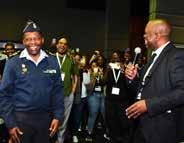
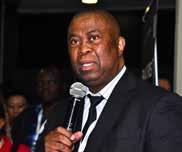
By fostering collaboration, sharing knowledge and inspiring future generations, the conference has undoubtedly contributed to the ongoing efforts to explore new frontiers in space. As the space industry continues to evolve, conferences like these play a vital role in shaping the future of space science.
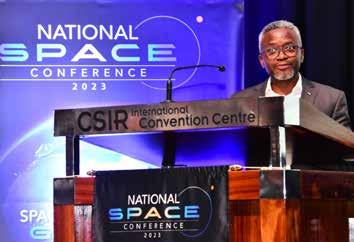
26 African Science Stars Issue 6 | www.africansciencestars.com
SPACE CONFERENCE
NATIONAL SCIENCE WEEK LAUNCH “TRANSFORMING LIVES THROUGH EVIDENCEBASED SCIENCE”
By: Lusanda Tamesi
National Science Week is an annual event aimed at advancing Science, Technology, Engineering and Mathematics (STEM) education and consciousness. It encompasses diverse activities such as exhibitions, workshops, lectures and interactive engagements to involve the public, notably students, in scientific exploration. The launch constitutes an official announcement by the Minister of Science and Innovation, Dr Blade Nzimande, signalling the commencement of the National Science Week for the broader public and learners nationally.
This year’s National Science Week launch took place at the University of Venda in Thohoyandou, Limpopo. Despite the drizzle, researchers from various organisations crowded the exhibition stands, featuring a range of sciences including space, energy, astronomy and the pride of the Limpopo province – agriculture. Prior to the event, government officials toured the exhibits to explore the nation’s diverse scientific offerings.
Under the theme “Transforming lives through evidence-based science”, its purpose is to entrench the concept of science as the solution to everyday problems, and encourage young people to enter careers in STEM to help take the country forward.

Dr Phil Mjwara, the Director General of the Department of Science and Innovation, opened the event with introductory remarks, followed by the national anthem performed by the Univen Musical Group.
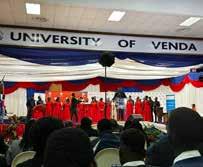
Notable attendees included prominent figures from the science field, community leaders, government officials and the general public. Dr Bernard Nthambeleni (Vice-Chancellor of the University of Venda), Mr Humbulani Mudau (CEO of SANSA), Councillor Nenguda Dowelani (Executive Mayor of Vhembe District) and Dr Mamoeletsi Mosia (Managing Director of SAASTA), were among the participants.
The launch coincided with the birthday of the late former president, Nelson Rolihlahla Mandela. The Minister, Dr Nzimande, cited Mandela’s famous words, “It always seems impossible until it’s done.” Speaking virtually, Dr Blade Nzimande thanked all esteemed guests for attending the launch, highlighting to learners that without them National Science Week would not have been possible.
National Science Week encourages students to embrace science careers in a fun way, dispelling the notion of it being difficult. Science and innovation drive economic growth and inclusivity, with programmes focusing on youth, women and those with disabilities. Inclusion of people with disabilities is highlighted as essential for genuine scientific progress.
Engaging the general public is a challenging task, as a lack of positive response can signal ineffective communication. To address this, the government has adopted various science communication strategies, including the introduction of a ‘citizen science’ project. This involves collaboration between citizens and researchers to address common issues. In South Africa, there are seven citizen science projects currently underway in universities, with one well-known project being MeerKAT.
MeerKAT, a precursor to the Square Kilometre Array (SKA) project, is in its second phase of data collection in the Northern Cape. Unlike the first phase, which was studied abroad, this phase is being studied in South Africa. The collected data focuses on MeerKAT’s role in astronomy and is shared with the public. Minister Nzimande highlighted the establishment of the MeerKAT citizen science initiative, encouraging public participation in analysing the second data set.
An inspiring example comes from Thengwe Secondary School, highlighted by speaker Uatshila Munenyiwa during the launch. Her project earned her the 2023 South Africa Youth Water Prize at the provincial level. Munenyiwa shared that her teacher motivated their class to join an innovators competition. One task was to identify a school problem, and recognising water and sanitation issues led her to victory.
The Minister urged principals and teachers to enhance their efforts in involving more students in Science, Technology, Engineering, Mathematics and Innovation (STEMI) Olympiads. He emphasised the importance of not discouraging learners from choosing mathematics, contrary to some principals’ approach of avoiding it for better school results.
27 African Science Stars Issue 6 | www.africansciencestars.com
NATIONAL SCIENCE WEEK
MAX PLANCK SOCIETY ORGANISES ASTRONOMY SCHOOL IN AFRICA… THE MAX PLANCK AFRICAN ASTRONOMY SCHOOL
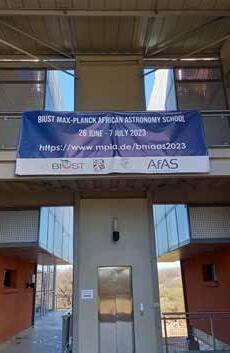
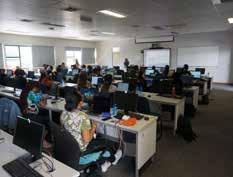

The Max Planck Institute for Astronomy and Botswana International University of Science and Technology (BIUST) recently collaborated on a significant educational event aimed at shaping the future of astronomy in Africa. We interviewed Dr Coryn Bailer-Jones, a staff scientist and group leader at the Max Planck Institute for Astronomy, who played a key role in organising this groundbreaking initiative.
The primary goal of this event was to facilitate the transition for students from undergraduate to graduate-level astronomy research. Dr Bailer-Jones explained that participants came from diverse academic backgrounds, some with bachelor’s degrees, some with master’s degrees, and even a few with PhDs. However, they all shared a commonality: they were at the outset of their research careers.
The programme aimed to provide guidance on both the science of astronomy and the practical tools and skills needed for research. Participants were exposed to topics ranging from exoplanets to cosmology, and they learned essential skills like data access, statistics and machine learning.
A student from the University of Nambia, Hiiko Katjaita, said, “The event has been quite good; it’s quite a diverse group of students. The pinnacle of the school has been the hands-on activities because it gives you hands-on practice on work done by the professionals in the field of astronomy.”
Additionally, this event served as a networking opportunity, connecting 33 students from 15 African countries with 11 lecturers from 8 countries in Africa and Europe. The importance of these connections cannot be overstated, as they fostered collaborations and research opportunities among participants.
The event was open to students from all African countries who were registered at or had recently completed studies at African universities. Nationality was not a determining factor. The venue, BIUST, was chosen partly due to the availability of local support.
Organising such an event involves funding not only for travel but also for accommodation, meals, local transport and logistics. Dr Bailer-Jones acknowledged the critical role played by BIUST and local
contacts in making the event a reality.
Regarding the event’s outcomes, Dr BailerJones shared that expectations were not only met but exceeded in some respects. The students demonstrated a high level of interest and engagement, often leading to extended lecture sessions due to the many questions asked.
An exciting highlight was a remote observing session, during which a student controlled a telescope from Cape Town while Dr Bailer-Jones and others observed remotely and fielded questions from the participants in Botswana.
When asked about the event’s future, Dr Bailer-Jones expressed interest in repeating such schools, perhaps every other year or as a biennial event. The goal is to continue nurturing young astronomers in Africa and identifying promising students for joint supervision in research projects. While the frequency of such events may vary, the commitment to fostering astronomy on the African continent remains steadfast.
28 African Science Stars Issue 6 | www.africansciencestars.com
ASTRONOMY SCHOOL
THE INTERNATIONAL ASTRONOMY UNION OFFICE OF ASTRONOMY FOR
EDUCATION
By: Tshiamiso Makwela
The International Astronomy Union Office of Astronomy for Education (OAE) was founded in 2019 and is hosted by the Haus fur Astronomie at the Max Planck Institute of Astronomy in Heidelberg, Germany. The OAE is dedicated to astronomy for primary and secondary education.
There are five objectives that the OAE is actively working towards: (1) Professionalise astronomy education, (2) provide access to good resources, (3) promote astronomy within school curricula, (4) create, maintain and grow the network, and (5) to spread the news and inform all stakeholders. These objectives serve as a goal that the OAE aims to reach globally.
The OAE launched a call for the Teacher Training Program (TTP) in 2023, which follows the success of the TTP pilot which started in 2022. Through TTP, the OAE has been able to reach out to a number of countries interested in improving teachers’ knowledge of astronomy.
TTP is designed in a way that it is contextual, where the training is organised by the local people in that region, for example: a National Astronomy Education Coordinators (NAEC), an astronomer, and a local teacher, as such each TTP is unique.
The OAE annually hosts the virtual SHAW-IAU workshops on astronomy for education. These workshops have been able to reach out to almost 700 people across the world. The ShawIAU Workshops work well as they allow for the exchange of experiences and best practices from different people in different countries. The workshop talks and posters are content that are available to all interested, and the summaries are published in our proceedings. Both TTP and Shaw-IAU Workshops simultaneously work towards one of the main goals of the OAE, which is to foster the professionalisation of astronomy education.
With regard to providing good resources, the OAE has set up key structures that are open source, such as AstroEDU which has great activities that teachers can implement in their classroom. The multilingual Glossary, and Big Ideas in Astronomy, which are our guide for astronomy literacy, as well as the Astrophotography Contest, which offers high-resolution images that can be used for teaching as well.
The OAE is also working hard towards creating a network of NAECs, who are the point of contact in countries, which the OAE collaborates with. While there are some African countries that have NAECs, the majority of Africa is still missing NAECs. If you are interested and working towards improving astronomy education in your country please reach out to the OAE, and collaborate towards improving astronomy education globally.
The OAE aims to be the first point of contact for practitioners (teachers, astronomers, science centre personnel, amateur astronomers), who often face the challenge of not knowing where to start or how to start including astronomy in countries, curriculum, and in their teaching.
For more, visit astro4edu.org or email oae@astro4edu.org
Links
OAE: astro4edu.org/about-us/
TTP: astro4edu.org/ttp/
SHAW-IAU: astro4edu.org/shaw-iau/
Proceedings: astro4edu.org/news/s4199sh/
AstroEDU: astroedu.iau.org/en/
Big Ideas: astro4edu.org/bigideas/
Multilingual Glossary: astro4edu.org/resources/glossary/search/
Astrophotography: astro4edu.org/oae-astrophoto-contest-2023/
NAECs: astro4edu.org/naec-network/
Join the mailing: astro4edu.org/mailing-list/
29 African Science Stars Issue 6 | www.africansciencestars.com EDUCATION
A d d i s A b a b a , E t h i o p i a h t t p s : / / i a u 3 8 6 . e s s t i . g o v . e t / T h e I A U 3 8 6 s y m p o s i u m f o c u s o n p r e s e n t i n g r e s e a r c h f i n d i n g s a n d s h a r i n g e x p e r i e n c e s t o e n h a n c e p r e s e r v a t i o n a n d u t i l i z a t i o n o f d a r k s k y , d i s c u s s i n g o n m e c h a n i s m s h o w t o b o o s t A s t r o - t o u r i s m a r o u n d t h e w o r l d a n d s t r a t e g i e s f o r u t i l i z i n g a n d i n v e s t i n g u n t a p p e d d a r k s k y r e s o u r c e a r o u n d t h e w o r l d . T h e s y m p o s i u m a l s o c o n s i s t s o f d i f f e r e n t s i d e e v e n t a c t i v i t i e s b e y o n d t h e s c i e n t i f i c d e l i b e r a t i o n s s u c h a s p u b l i c l e c t u r e s , c a p a c i t y b u i l d i n g a n d a w a r e n e s s c r e a t i o n t r a i n i n g o n ‘ D a r k s k y a n d A s t r o - t o u r i s m ’ f o r s t a k e h o l d e r s i n t h e i n d u s t r y , a s w e l l a s f o r d e c i s i o n a n d p o l i c y m a k e r s .

T O P I C S O F T H E S Y M P O S I U M
D a r k S k y a n d i t s p r e s e r v a t i o n
A r t i f i c i a l L i g h t a t N i g h t ( A L A N )
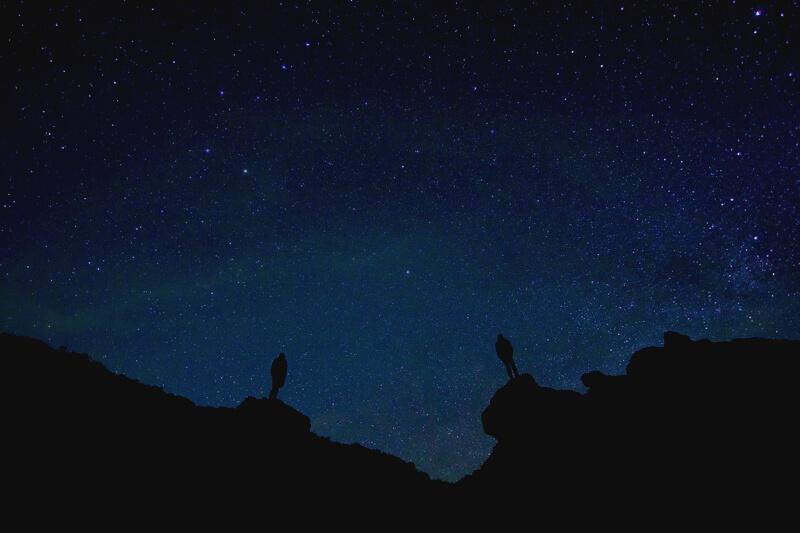
A r t i f i c i a l l i g h t p o l l u t i o n a n d C i t y e x p a n s i o n A s t r o n o m i c a l S i t e P r o t e c t i o n G r o u n d - b a s e d A s t r o n o m y O b s e r v a t i o n B i o - E n v i r o n m e n t a n d H u m a n H e a l t h I m p a c t o f S a t e l l i t e C o n s t e l l a t i o n s I m p a c t o n R a d i o a s t r o n o m y M e a s u r i n g a n d M o d e l i n g A L A N
A s t r o - t o u r i s m
A s t r o - t o u r i s m a n d S o c i o - e c o n o m i c d e v e l o p m e n t . T o u r i s m a s c u l t u r a l d i a l o g u e
S

N T I F I C O R G A N I Z I N G C O M M I T T E E ( S O C )
A l e m i y e M a m o Y a c o b ( M ) , E a s t A f r i c a r e g i o n a l o f f i c e o f A s t r o n o m y f o r D e v e l o p m e n t ( E A - R O A D ) a n d S p a c e S c i e n c e a n d T e c h n o l o g y I n s t i t u t e ( S S G I ) , E t h i o p i a – C h a i r M i r j a n a P o v i ć , S p a c e S c i e n c e a n d T e c h n o l o g y I n s t i t u t e ( S S G I ) a n d I n s t i t u t o d e A s t r o f í s i c a d e A n d a l u c í a ( I A A ) , S p a n i s h N a t i o n a l R e s e a r c h C o u n c i l ( C S I C ) , E t h i o p i a – C oc h a i r C o n n i e W a l k e r ( F ) , N S F ’ s N O I R L a b , U S A ( C o - c h a i r )
K a t r i e n K o l e n b e r g ( F ) , K U L e u v e n a n d U n i v e r s i t y o f
A n t w e r p , B e l g i u m ( C o - c h a i r )
J o h n H e a r n s h a w ( M ) , U n i v e r s i t y o f C a n t e r b u r y , N e w
Z e a l a n d
C a r o l i n a O d e m a n ( F ) , U n i v e r s i t y o f W e s t e r n C a p e , S o u t h
A f r i c a
J a r i t a C H o l b r o o k ( F ) , U n i v e r s i t y o f E d i n b u r g h , U K
T h e b e M e d u p e ( M ) , N o r t h W e s t U n i v e r s i t y , M a f i k e n g , S o u t h A f r i c a
D a r k s k i e s , c u l t u r a l a s t r o n o m y , a n d a s t r o n o m i c a l h e r i t a g e
E x p e r i e n c e , c h a l l e n g e s a n d o p p o r t u n i t i e s o f A s t r ot o u r i s m C u l t u r a l a s t r o n o m y
A r c h e o a s t r o n o m y E t h n o a s t r o n o m y A s t r o n o m i c a l h e r i t a g e
D a r k s k i e s f o r s c i e n c e a n d t e c h n o l o g i c a l d e v e l o p m e n t s
E d u c a t i o n , o u t r e a c h a n d d e v e l o p m e n t a c t i v i t i e s o f d a r k s k i e s a n d A s t r o - t o u r i s m
P o l i c y a n d i m p l e m e n t a t i o n f r a m e w o r k o f d a r k a n d q u i e t s k y
J u a n A n t o n i o B e l m o n t e A v i l e s ( M ) , I n s t i t u t o d e
A s t r o f í s i c a d e C a n a r i a s ( I A C ) , S p a i n
S o n a l A s g o t r a a ( F ) , I A U - O A D , S o u t h A f r i c a ,
N i r u j M o h a n R a m a n u j a m ( M ) , I n d i a n I n s t i t u t e o f
A s t r o p h y s i c s , I n d i a
P i e r o B e n v e n u t i ( M ) , U n i v e r s i t y o f P a d o v a , I t a l y
Z o u h a i r B e n k h a l d o u n ( M ) , O u k a i m e d e n O b s / U n i o f
M a r r a q u e c h , M o r o c c o
N o o r a l i J i w a j i ( M ) , O p e n u n i v e r s i t y o f T a n z a n i a ,
T a n z a n i a
B o n a v e n t u r e O k e r e ( M ) , N a t i o n a l S p a c e R e s e a r c h a n d
D e v e l o p m e n t A g e n c y ( N A S R D A ) a n d W e s t A f r i c a R O A D ,
N i g e r i a
G e o f f r e y O k e n g ’ o ( M ) , U n i v e r s i t y o f N a i r o b i a n d E a s t
A f r i c a A s t r o n o m i c a l S o c i e t y ( E A A S ) , K e n y a
C A L L F O R A B S T R A C T S U B M I S S I O N A N D R E G I S T R A T I O N 1 s t A N N O U N C M E N T I A U S Y M P O S I U M 3 8 6 D A R K S K Y A N D A S T R O N O M I C A L H E R I T A G E I N B O O S T I N G A S T R O - T O U R I S M A R O U N D T H E G L O B E 1
2 0 2 3
R E G I S T R A T I O N F E E C A T E G O R Y E A R L Y B I D R E G I S T R A T I O N R E G U L A R R E G I S T R A T I O N L A T E / O N S I T E R E G I S T R A T I O N R E G U L A R S T U D E N T € 2 0 0 € 2 5 0 € 3 0 0 € 2 0 0 € 1 8 0 € 1 5 0
3 - 1 7 N o v
C I E
I M P O R T A
N
- R e g u l a r R e g i s t r a t i o n d e a d l i n e
:
N O T E
a n -

0 J u n e
:
1 5 M a y 2 0 2 3
o n

: 2 0 J u n e 2 0 2 3


h a i r - F e r a o l F a n a ( M ) , S S G I , E t h i o p i a , c o - c h a i r

- J e r u s a l e m T a m i r a t ( F ) , S S G I , E t h i o p i a
- B e t e l e h e m B i l a t a ( F ) , S S G I , E t h i o p i a

- E t s e g e n e t G e t a c h e w ( F ) , S S G I , E t h i o p i a
- T o l u B i r e s s a ( M ) , J i m m a U n i v e r s i t y , E t h i o p i a
- G e t i n e t F e l e k e ( M ) , K o t e b e M e t r o p o l i t a n U n i v e r s i t y , E t h i o p i a


- Z e l e k e B e y o r o ( M ) , ( K M U ) , E t h i o p i a
- F r e h i w o t G a r o m s s a ( F ) , S S G I , E t h i o p i a
- F e l e k e Z e r i h u n T e r e f e ( M ) , S S G I , E t h i o p i a
- N a t h n a e l F e k a d u ( M ) , S S G I , E t h i o p i a
- W o n d e m a g n G i r m a , ( M ) , F . D . R . E T o u r i s m M i n i s t r y ( M O T )

F o r a n y i n f o r m a t i o n r e q u e s t a n d y o u c a n c o n t a c t u s v i a i a u 3 8 6 @ e s s t i . g o v . e t .
F o r h a v i n g d e t a i l i n f o r m a t i o n o f t h e s y m p o s i u m , y o u c a n c o n t a c t s y m p o s i u m c h a i r A l e m i y e M a m o v i a a l e m i y e m @ e s s t i . g o v . e t / m a l e m i y e @ g m a i l . c o m ; o r t h e s y m p o s i u m C o - c h a i r s D r . M i r j a n a P o v i c m p o v i c @ i a a . e s a n d D r . S e b l u H u m n e s e b l u 1 5 5 7 @ g m a i l . c o m
h t t p s : / / i a u 3 8 6 . e s s t i . g o v . e t /

E m a i l : i a u 3 8 6 @ e s s t i . g o v . e t

C A L L F O R A B S T R A C T S U B M I S S I O N A N D R E G I S T R A T I O N 1 s t A N N O U N C M E N T I A U S Y M P O S I U M 3 8 6 D A R K S K Y A N D A S T R O N O M I C A L H E R I T A G E I N B O O S T I N G A S T R O - T O U R I S M A R O U N D T H E G L O B E 1 3 - 1 7 N o v 2 0 2 3 A d d i s A b a b a , E t h i o p i a h t t p s : / / i a u 3 8 6 . e s s t i . g o v . e t / L O C A L O R G A N I Z I N G C O M M I T T E E ( L O C ) - S e b l u H u m n e N e g u ( M ) , S S G I , E t h i o p i a , - c h a i r - A l e m i y e M a m o Y a c o b ( M ) , S S G I & E A - R O A D , E t h i o p i a - C o - c h a i r - S h a m b e l S a h e l u ( M ) , S S G I , E t h i o p i a , c o - c h a i r - G e m e c h u M u l e t a ( M ) S S G I , E t h i o p i a , c o - c h a i r - M i r j a n a P o v i ć ( F ) S S G I , E t h i o p i a a n d I A A - C S I C , S p a i n , c o - c
- B i r u k T e r e f e ( M ) , E t h i o p i a n S p a c e S c i e n c e S o c i e t y ( E S S S ) T D A T E S
1 5 S e p t 2 0 2 2
- R e g i s t r a t i o n & A b s t r a c t S u b m i s s i o n O p e n s
3 1 D e c 2 0 2 2
3 1 A u g u s t 2 0 2 3
- E a r l y B i r d r e g i s t r a t i o n d e a d l i n e :
0 1 S e p t 2 0 2 3
- L a t e / o n s i t e R e g i s t r a t i o n s t a r t s :
- A b s t r a c t S u b m i s s i o n d e a d l i n e :
- A b s t r a c t A c c e p t a n c e n o t i f i c a t i
1 5 J
1 5 M
2 0 2 3
- G r a n t A p p l i c a t i o n :
a y
2
2 0 2 3
- G r a n t N o t i f i c a t i o n :
Y o u c a n r e g i s t e r s u b m i t y o u r a b s t r a c t v i a t h e w e b s i t e r e g i s t r a t i o n a n d d e t a i l b a n k a c c o u n t f o r t r a n s f e r w i l l b e p o s t e d s o o n .
INDIA’S HISTORIC ACHIEVEMENTCHANDRAYAAN-3 TOUCHES DOWN ON THE MOON
In a monumental leap for space exploration, India has made history once again with the successful landing of their unmanned rover, Chandrayaan-3, on the lunar surface. This remarkable achievement marks a significant milestone for India’s space programme and reaffirms the nation’s commitment to advancing scientific knowledge and space exploration.
Chandrayaan-3, the third mission in the Chandrayaan series, has been a culmination of years of meticulous planning, rigorous testing, and unwavering dedication from the Indian Space Research Organisation (ISRO).
The rover’s primary objective is to continue the work of its predecessors, Chandrayaan-1 and Chandrayaan-2, by conducting detailed scientific studies and experiments on the moon’s surface.
The mission’s success is not only a testament to India’s growing capabilities in space exploration but also highlights its commitment to international cooperation in the field.
One of the key scientific goals of Chandrayaan-3 is to unravel the mysteries of the moon’s composition and geological history. Equipped with state-of-the-art cameras, the rover will analyse the lunar soil and rocks to gain insights into the moon’s formation and evolution. This information could provide valuable clues about the early history of our solar system.
Additionally, Chandrayaan-3 will conduct experiments to study the moon’s exosphere and its interaction with the solar wind. This research will contribute to our understanding of space weather and its potential impact on future lunar missions and space travel.
The successful landing of Chandrayaan-3 also carries significant implications for future lunar exploration efforts. It showcases India’s proficiency in autonomous navigation and landing technologies, which are essential for future manned missions to the moon and beyond.
Moreover, Chandrayaan-3’s mission will serve as a stepping stone for international collaboration in space exploration. The exchange of scientific data and findings with other nations will enhance our collective understanding of the moon and the broader cosmos. This spirit of cooperation exemplifies the global nature of space exploration, where discoveries benefit all of humanity.
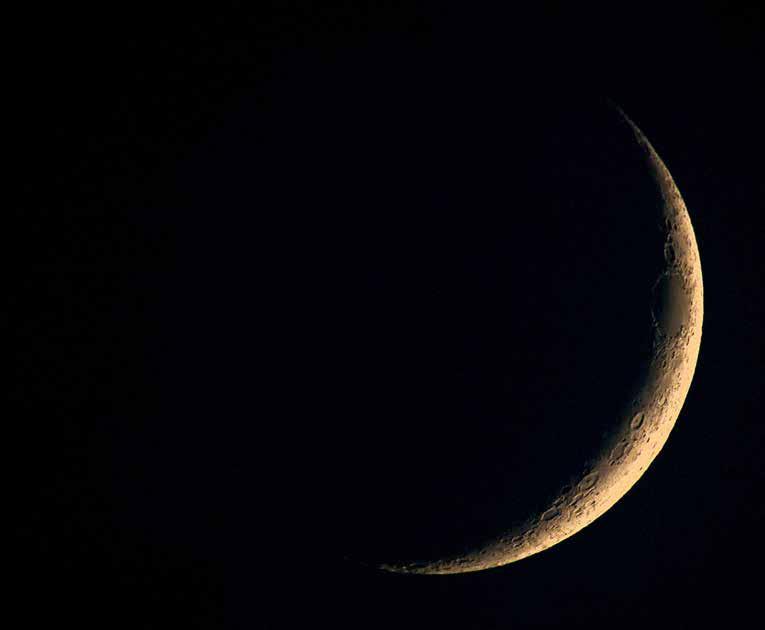
The success of Chandrayaan-3 is also a source of immense national pride for India. It showcases the nation’s dedication to scientific advancement and the spirit of innovation that drives its space program. The mission serves as an inspiration to countless young minds across India, encouraging them to pursue careers in STEM fields.
As Chandrayaan-3 embarks on its mission to explore the moon, it will undoubtedly capture the imagination of people worldwide. Its discoveries and findings will not only expand our knowledge of the moon but also contribute to our broader understanding of the universe and our place within it.
India’s successful landing of Chandrayaan-3 on the moon is a remarkable achievement that reaffirms the nation’s standing in space exploration. This mission not only advances our scientific knowledge of the moon but also sets the stage for future lunar exploration endeavours.
32 African Science Stars Issue 6 | www.africansciencestars.com MOON LANDING
A WEEK OF SPACE SCIENCE TRAINING AT THE ETHIOPIAN SPACE SCIENCE SOCIETY
By: Lillian Assefa
With its vast expanse and limitless wonders, the universe has always beckoned to humanity’s innate curiosity. To satiate this curiosity and deepen the understanding of the cosmos amongst youngsters, the Ethiopian Space Science Society recently hosted an intensive week-long Space Science Training programme, which was held from 7-12 August. This immersive experience brought together young space enthusiasts eager to uncover the secrets of the universe.
The week-long program was held at the Addis Ababa Institute of Technology, setting the stage for an unforgettable journey into the realm of space science in the country. The primary objective of this program was to provide a comprehensive overview of the field, offering students in the age range of 8-21 a holistic understanding of astronomy, aerospace and astrophysics.
The training encompassed a vast array of topics within these ranges. From the awe-inspiring birth of stars to the enigmatic mysteries of black holes, participants embarked on a deep dive into the heart of astronomy. Space science was a central theme, with in-depth discussions on upcoming missions to Mars and the far reaches of our solar system. Participants explored the latest technological advancements in space telescopes shedding light on the tools that unlock the universe’s secrets.
What truly set this year’s training apart is that its practical component was equally enlightening. Participants had the unique opportunity to operate powerful telescopes. These hands-on experiences breathed life into theoretical knowledge, fostering a deeper understanding of the cosmos within them.
The society also recognised the importance of providing a holistic educational experience. To ignite the students’ passion for aerospace science, they organised an enlightening field trip to Ethiopian Airlines, where the children had the exceptional opportunity to engage with aerospace experts and gain hands-on insights into the captivating world of aerospace. This eye-opening experience not only broadened their horizons but also kindled a profound curiosity for the boundless possibilities of aeronautics.
The enthusiasm among participants was palpable throughout the week. Kalab, a very active middle school student, said: “I never imagined I could operate a telescope. This experience has ignited a lifelong passion for space!”
Kidist, a high school senior student, added, “The in-depth discussions on space technology have given me a profound new perspective on my next steps after graduation.”
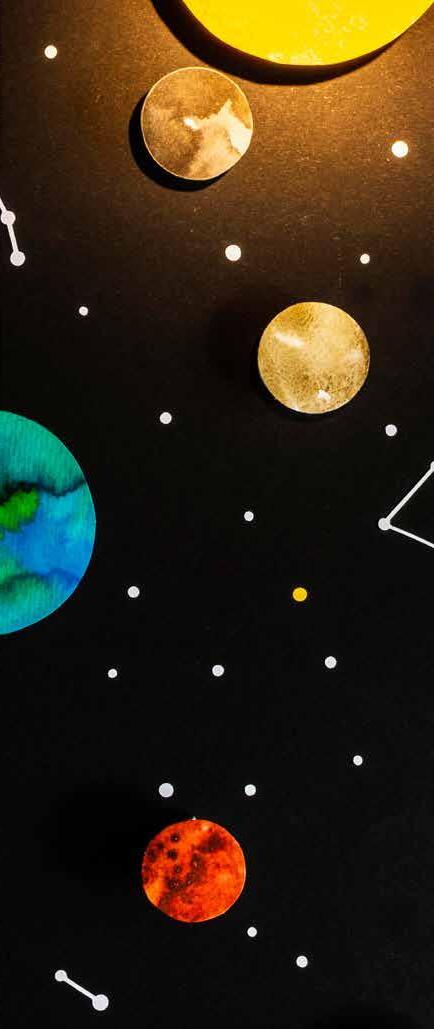
Beyond the classroom, participants forged meaningful connections with fellow space enthusiasts. Mid-break brainstorming sessions often spilled into animated discussions about potential guidance for their future academics. The training not only enriched their knowledge but also cultivated a vibrant sense of community among space fans.
Finally, to recognise and celebrate the remarkable dedication and enthusiasm displayed by some of the exceptional students during the Space Science Training program, a select few were chosen based on their outstanding classroom performance. These talented individuals were given the unique privilege of presenting their newfound knowledge and insights, showcasing the depth of understanding they had acquired in just a few short days. Their presentations served as a testament to the transformative power of hands-on education and the bright future of space science enthusiasts in the country.
As the week concluded, a sense of accomplishment and inspiration permeated the atmosphere. The Space Science Training had successfully kindled the spark of curiosity in all who attended. It bridged the gap between theory and practice, making the cosmos seem more accessible and captivating than ever before. This experience was a testament to the organisation’s unwavering commitment to advancing knowledge in the field of space science in Ethiopia.
This program will also continue in other cities in Ethiopia, expanding its reach and impact, and ensuring the fascination and education surrounding space science and exploration. I can proudly say that Addis Ababa’s training was completed with tremendous success and for all those youngsters who attended, it was a week of wonder and inspiration that will continue to shape their cosmic pursuits for years to come.
For more information, contact Lillian, the event organiser, at Lillianalehegn123@gmail.com
33 African Science Stars Issue 6 | www.africansciencestars.com SPACE TRAINING
ANNOUNCEMENT OF SALT TIME FOR PAN-AFRICAN ASTRONOMERS
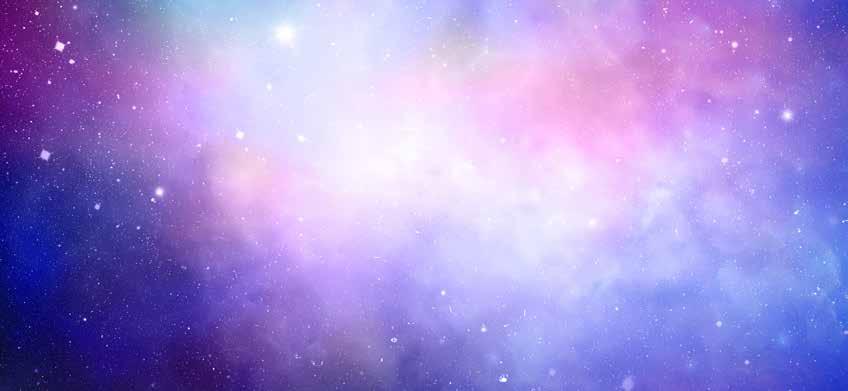
In July 2022, the Southern African Large Telescope (SALT) announced time open to African astronomers as part of the South African timeshare. SALT would like to encourage the use of the telescope by astronomers across the continent. The South African Time Allocation committee will therefore be accepting observing proposals from African, but non-South African, Principal Investigators (PIs).
SALT is a fully-queue-scheduled telescope, as are most of the major telescopes across the world. This means that when the PIs submit proposals, the observations are done by the telescope’s service astronomers and data are sent back to the PIs. The call for proposals is sent out twice a year, and proposals need to be prepared using the Principal Investigator Proposal Tool as well as other simulator tools for the individual instruments. Links to these resources can be found at the SALT website under astronomers.salt.ac.za/proposals/ and astronomers.salt.ac.za/ software/ respectively.
To apply for time on SALT, the PIs are encouraged to collaborate with an astronomer based in South Africa, or contact any of the SALT astronomers for help by emailing salthelp@salt.ac.za
There are currently three instruments functioning on SALT. The main instrument is the Robert Stobie Spectrograph (RSS), which is capable of both spectroscopy and narrow-band imaging in the wavelength range 360-900nm. The spectroscopic modes on RSS include traditional long-slit spectroscopy, multi-object spectroscopy, high time-resolution spectroscopy and long-slit spectropolarimetry. With an assortment of VPH gratings, it is capable of a wide range of spectral resolutions and wavelength ranges. RSS is well suited for large spectroscopic surveys and imaging of low surface brightness objects.
The High Resolution Spectrograph (HRS) is a fibre-fed echelle spectrograph meant for single object spectroscopy. With four resolution modes, it reaches radial velocity accuracies of 150m/s, although a laser comb is currently being installed to achieve higher accuracy. HRS is well suited for science on planetary nebulae, cataclysmic variables, pulsars and other transients. The SALT Imaging Camera (SALTICAM) is the acquisition camera, but also used for normal imaging, and both moderate and high time-resolution imaging.
The newest instrument on SALT, still under commissioning, is the Near-Infrared Spectrograph (NIRWALS), an integral field unit spectrograph operating in the 800nm-1700nm regime achieving moderate resolution of R=5000. The telescope can switch between instruments on-demand within a short time, making it versatile for all observations. This versatility earned SALT a place in the observation of the Gravitational Wave event of 2017.
The scientific impact of SALT has been impressive over the past decade and its output has compared well with other worldclass telescopes. The figure below shows a normalised plot of scientific outputs from several telescopes. To-date, there has been very little involvement of African PIs from the rest of the continent. To increase participation across the continent, SALT is partnering with AfAS to increase accessibility of SALT time to non-South African based astronomers. A hybrid workshop was held in Cape Town in November 2022 to aid the user community in handling data from the telescope, and more such workshops will be held in the future.
Astronomers who are interested in finding out more about this call, and would like to inquire about the process of application, as well as how to handle the data, etc., can reach out on: salthelp@salt.ac.za
34 African Science Stars Issue 6 | www.africansciencestars.com
SALT
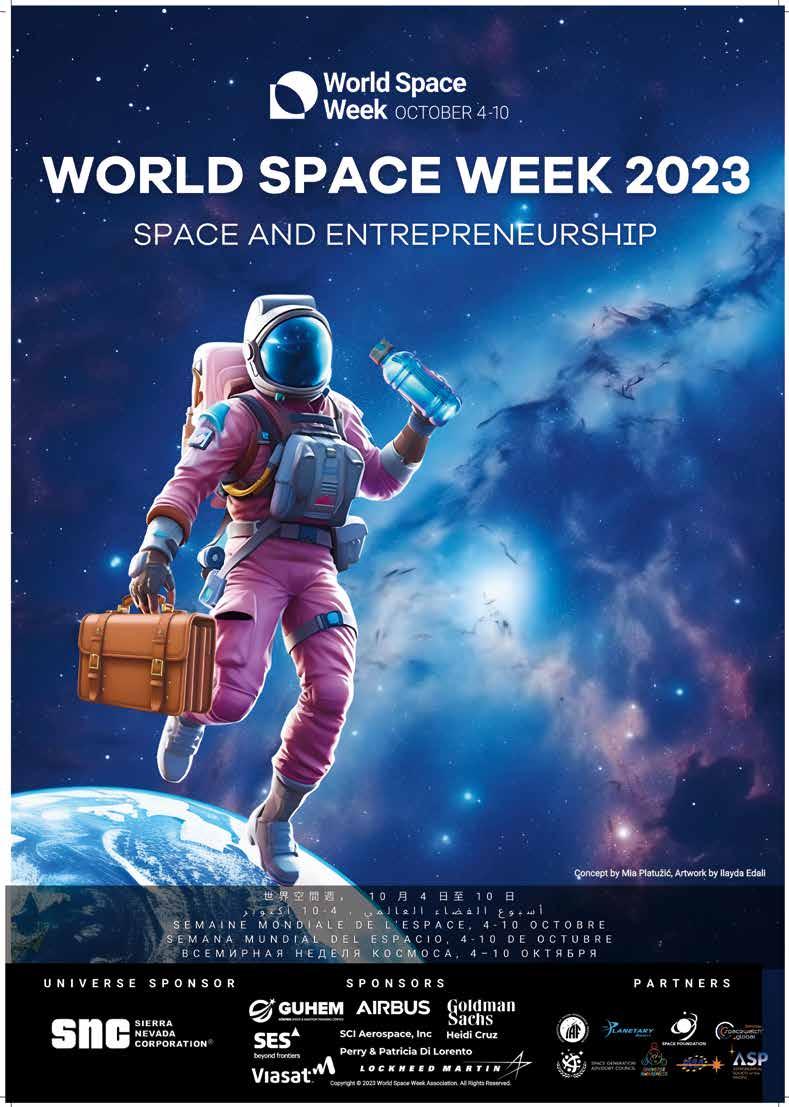
DSI-SANSA TEAM EXPLORES ETHIOPIA’S ASTRONOMICAL HERITAGE AND COLLABORATIVE POTENTIAL

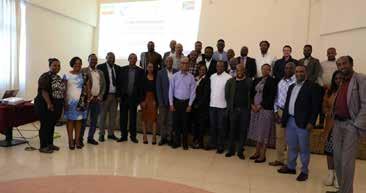
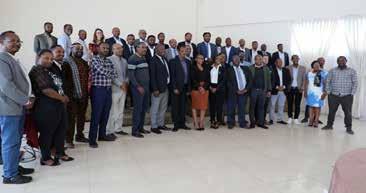 By: Lusanda Tamesi
By: Lusanda Tamesi
Ethiopia’s history is intertwined with its contributions to science and astronomy. From the ancient Kingdom of Aksum, known for its sundial obelisks, to the Ethiopian Orthodox Church’s calendar system, the country’s heritage reflects its fascination with the cosmos. The modern era sees the rise of institutions like the Entoto Observatory, striving to advance astronomical research. Ethiopian scientists are always committed to exploration. By preserving its scientific heritage and fostering new generations of researchers, Ethiopia continues its journey of uncovering the universe’s mysteries. This legacy underscore the nation’s enduring curiosity about the world and beyond, promising exciting contributions to the global scientific community.
We had the privilege of speaking with Mr Jonathan Ward, acting Managing Director of the Space Science Programme who is responsible for South African National Space Agency (SANSA)’s geophysical instrumentation and its deployment in Africa and Mr Lesiba Tsoeleng, a Remote Sensing Scientist within SANSA’s Earth Observation (EO) Programme, about their recent visit to Ethiopia and the significance of this journey.
36 African Science Stars Issue 6 | www.africansciencestars.com DSI - SANSA
Exploring Ethiopia: A journey of cultural discovery and scientific collaboration
The Ethiopian Ministry of Innovation and Technology (MiNT) invited the South African Department of Science and Innovation (DSI) and its entities, for an experts technical meeting to be held in Ethiopia’s capital, Addis Ababa, from 23-26 May 2023. This visit offered a unique opportunity to explore Ethiopia’s rich scientific and cultural heritage.
“My experience of visiting Ethiopia was getting exposure to learn and understand Ethiopia’s National System of Innovation, their culture, and value proposition to evaluate and provide contributions on possible areas of collaboration. The motivation was to respond to an invitation from DSI in joining the department’s delegation to engage with MiNT delegation on areas of collaboration”, said Mr Tsoeleng.
Ethiopia’s warm and welcoming hosts ensured a harmonious blend of cultural immersion and professional engagements.
The DSI-SANSA team had the opportunity to visit various astronomical sites, observatories and facilities in Ethiopia, including:
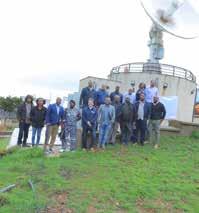
• Ethiopian Space Science and Geospatial Institute (SSGI): This institution aligns with SANSA’s mandate and paves the way for collaboration in areas such as Geomagnetism and Ionospheric Studies.

• Entoto Observatory: Another critical visit for SANSA, as it mirrors their work in using satellite data for research purposes.
• BETIN Lab: An integral part of Ethiopia’s scientific landscape.
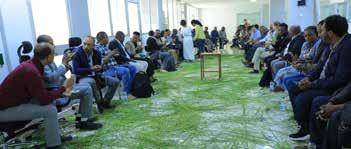
• National Veterinary Institute, Science Museum, and IT Park: Reflecting the diverse facets of Ethiopia’s scientific pursuits.
Mr Jonathan Ward notes, “Of particular interest was the visit to the SSGI and the Entoto Observatory as this directly lines up with SANSA’s mandate. SANSA and SSGI will collaborate in two areas in the near future: Geomagnetism and Ionospheric Studies.”
Despite their professional commitments, the DSI-SANSA team found ample opportunities to appreciate Ethiopia’s cultural and historical background. “ We really appreciated the hospitality of our hosts who were committed to sharing many aspects of Ethiopia’s culture. There was a good balance between work events and cultural events. We are very eager to return in order to catch up on the things that we didn’t have time to do," said Mr Tsoeleng.
During their visit, the team fostered collaboration with local astronomers, researchers and institutions. Mr Ward confirmed, “ We continued with our collaboration with SSGI and were able to
make concrete plans to return to Ethiopia as well as for a team from SSGI to visit SANSA this year.”
Ethiopia’s geographic and climatic conditions offer unique advantages for space science, astronomy and stargazing activities. The Entoto Observatory’s proximity to the magnetic equator presents exciting opportunities for geomagnetic research.
Among the most cherished moments of their visit was an evening at an authentic Ethiopian restaurant, where traditional singing and dance performances by Ethiopian tribes showcased the nation’s cultural diversity. These interactions allowed the DSI-SANSA team to gain deeper insights into Ethiopia’s culture and economic value derived from coffee production and traditional music.
The visit reaffirmed the synergy and alignment between South African and Ethiopian Space Science programs. It illuminated the potential for knowledge exchange, training and joint projects. Ethiopia’s growing capabilities in satellite tracking and Earth Observation open doors for future collaborations that could benefit both nations and contribute to the broader field of astronomy and space science.
The DSI-SANSA team’s visit to Ethiopia was not only a scientific exploration but also a cultural exchange that promises fruitful collaborations in the realm of space science and beyond. Ethiopia’s commitment to preserving its scientific heritage and pursuing innovative endeavours ensures a bright future for the nation’s contributions to global scientific endeavours.
37 African Science Stars Issue 6 | www.africansciencestars.com DSI - SANSA
RIPPLES IN SPACETIME EVIDENCE OF GRAVITATIONAL WAVES DETECTED BY PULSAR TIMING ARRAY
By: Mukosi Fulufhelo
In the vast cosmic orchestra that is our universe, a new instrument has joined the ensemble, allowing us to hear the most subtle and awe-inspiring notes of existence: gravitational waves. These elusive ripples in spacetime, once predicted by Einstein’s theory of General Relativity, have recently been revealed by the Pulsar Timing Array, opening up a new avenue of understanding the cosmos.
Evidence of gravitational waves
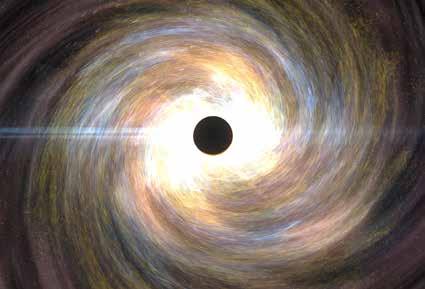
In a monumental leap for astrophysics, recent publications have unveiled the elusive nature of gravitational waves, all thanks to the pioneering work of astrophysicists with the Pulsar Timing Array (PTA). These studies showcased the collective efforts of astrophysicists who meticulously analysed data from a network of pulsars scattered across the sky.
One such publication was made by the North American Nanohertz Observatory for Gravitational Waves (NANOGrav). They observed a pattern of correlated timing residuals among a selection of pulsars – timing variations that could not be explained by causes we already know. Instead, these subtle variations (time variations) hinted at the presence of gravitational waves, ever so gently distorting the spacetime fabric between us and these pulsars.
Understanding gravitational waves
Think of the fabric of spacetime as a calm pond, with celestial bodies such as planets and stars resting upon its surface. When a stone is dropped into the water, it creates ripples that grow outward, distorting the previously calm surface.
Similarly, massive cosmic events like the collision of black holes or the merging of neutron stars send ripples through spacetime, moving and growing outward as gravitational waves. These are similar to the ripples on the pond, but instead of water, they warp the very fabric of the universe, carrying with them information about where they come from and what events created them.
different discoveries
This, however, was not the first detection of gravitational waves in human history. In 2015, The Laser Interferometer Gravitational-Wave Observatory (LIGO) made headlines by detecting the first-ever gravitational waves using enormous detectors that captured the collision of stellar black holes. This detection was like capturing the sharp, sudden notes in a musical piece – a sudden bang that was out of place.
These gravitational waves were also not very long, spanning only kilometres. The Pulsar Timing Array (PTA) harnesses the precision of pulsars (rapidly spinning neutron stars emitting radio signals with clock-like regularity). As gravitational waves pass through these signals, they slightly change the timing of the pulses, creating a delicate symphony of harmonics that researchers can decipher. These pulses are very subtle.
Why is this discovery exciting?
What’s exciting about these gravitational waves detected by PTA is the mystery behind their formation. In 2015, Astrophysicists were sure that the gravitational waves detected by LIGO came from the merger of two black holes. These are typically about 10-100 times heavier than our sun with wavelengths of about tens of kilometres and high frequencies. The gravitational waves detected by PTA span light years and have very low frequencies.
Astrophysicists thought they could come from pairs of supermassive black holes of masses billions of times bigger than our sun. However, from the recent data released from groups like NANOGrav, there may be some new science to explore. One tantalising theory is that this new discovery can help us peer into the very first moments of our universe since today we only know what our theoretical models tell us.
38 African Science Stars Issue 6 | www.africansciencestars.com
LIGO vs. Pulsar Timing Array: Different instruments,
SPACETIME
An artist’s impression of a Pulsar Source: astrobites.org
PARTICIPATION AT EAS2023: PAVING THE WAY TO IAUGA2024
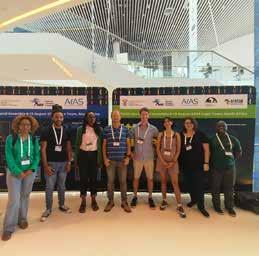
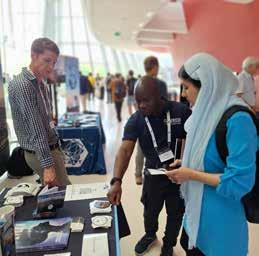
The European Astronomical Society (EAS) Conference of 2023, hosted in Krakow, Poland, from 10-14 July, served as a vibrant nexus for the global astronomical community. Notably, the event witnessed the enthusiastic involvement of the African Astronomical Society (AfAS) and the National Organizing Committee for the 2024 International Astronomical Union General Assembly (IAU-GA2024). This collaborative endeavor featured a diverse group of individuals representing various facets of African astronomy.
A host of prominent African organisations, including AfAS, IAU-GA2024, the African Planetarium Association (APA), the African Science Stars Publication (ASSAP), the South African Astronomical Observatory (SAAO), the IAU Office of Astronomy for Development (IAU-OAD), and the Southern African Large Telescope (SALT), converged at the conference. Together, they presented their contributions and vision through an engaging exhibition, highlighting the burgeoning role of Africa in the global astronomical landscape.
The climax of this astronomical rendezvous was the closing ceremony, where the spotlight fell on the National Organising Committee for IAU-GA2024, led by its chairman, Mr Kevin Govender, and the spirited representatives of the African astronomical community. They

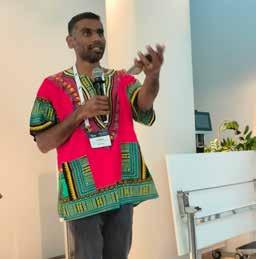
graciously extended an invitation for the EAS community to partake in the forthcoming General Assembly of the International Astronomical Union. This historic event will be hosted in Africa for the very first time, spanning from 6-15 August 2024.
Beyond a scientific exchange, this invitation was an embrace of Africa’s rich culture, indomitable spirit, and awe-inspiring natural beauty. Attendees were not just invited as delegates but also encouraged to become ambassadors, inviting their colleagues, institutions and families to join them on an enlightening expedition to Cape Town.
In a poignant moment, the South African coat of arms bearing the motto "! ke e: /xarra //ke, translating to “diverse people unite” was invoked as a call to celebrate the strength of diversity within the astronomy community and its contributions to society. Mr Govender’s heartfelt invitation emphasised that the IAUGA2024 would not only expand minds through scientific revelations but also touch hearts. This profound recognition of humanity’s richness was identified as the cornerstone of creativity, collaboration, and the achievement of greater heights in exploring the cosmos together.
The African delegation expressed heartfelt gratitude to the EAS for its steadfast support in nurturing astronomical research and fostering collaboration between Africa and Europe. As the presentation came to a close, the audience was treated to a stirring performance of “Shosholoza”, a South African song symbolising an invitation to embark on a transformative journey into Africa’s embrace.
EAS2023 served as an invaluable platform for forging connections, celebrating diversity, and kindling excitement for the impending IAU-GA2024. The conference not only showcased the burgeoning influence of African astronomy but also reinforced the idea that the pursuit of knowledge knows no boundaries, and the universe beckons as a shared frontier for all of humanity.
39 African Science Stars Issue 6 | www.africansciencestars.com
IAU-GA2024
FIRST FEMALE SCIENTIST IN MERCURY GEOMORPHOLOGY AND MAPPING IN TUNISIA
By: Lusanda Tamesi
Mayssa El Yazidi, 31, recently defended her thesis in Mercury Geomorphology Mapping in Tunisia. She’s the country’s first female scientist to obtain her PhD studies in Planetary Sciences.
What is mercury geomorphology and mapping?
Mercury geomorphology and mapping involves studying the surface features and shapes of the planet Mercury and creating detailed maps based on these features. Geomorphology refers to the study of how landscapes and landforms are shaped by natural processes over time. Mapping in this context means creating visual representations, like maps, that show different types of terrain, features, and their locations on Mercury’s surface. In simpler terms, it is like making a map that shows the different types of land on Mercury and how they came to be. This helps scientists learn about the planet’s past and how it has changed
over millions of years. It’s a bit like being a detective, trying to figure out the story of Mercury’s surface by looking at its rocks
From a young age, Ms Yazidi held a strong fascination for uncovering the mysteries of the universe, particularly the planets and the moon. This curiosity paved her way and directed her focus toward the study of Planetary Science. After successfully completing her Baccalaureate degree in 2011, she aspired to pursue her studies in Astronomy or Astrophysics.
However, the Republic of Tunisia did not offer such courses, nor related fields. In 2011, she was admitted to the Faculty of Sciences at Tunis, University Tunis El Manar, with the intent to undertake Geology courses. Although the coursework proved captivating and of great significance, her thoughts and spirit remained linked to the cosmos and the celestial bodies. It was during this period that the concept of exploring geology on an extraterrestrial scale emerged in her mind. This discipline is now recognised as Planetology or Planetary Science. She shared this innovative idea with one of her university professors, Prof. Slim Shimi Najet, who warmly embraced the concept and agreed to guide her. Her unwavering belief, guidance and fortitude bolstered their determination to progress.
Since 2011, a strong collaborative partnership flourished between her and Prof. Slim Shimi Najet. She supervised her bachelor’s research project titled “Comparative Geology of Celestial Bodies of the Solar System”
Road to becoming
“In 2014 I was the first student in the Republic of Tunisia to deliver a research project thesis for my bachelor’s degree in Planetary Science, successively in 2016 I defended my Masters thesis about the geology of Mars”, said Ms Yazidi.
Nowadays, Ms Yazidi completed her PhD in sciences,
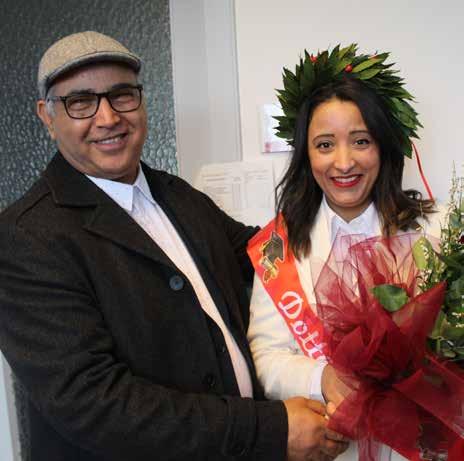
40 African Science Stars Issue 6 | www.africansciencestars.com
TUNISIA
technologies, and measurements for space from the University of Padova, with emphasis on geological mapping, structural and geomorphological analysis for some areas of interest on Mars and Mercury, on 23 January 2023. That allowed her to be the first female in the Republic of Tunisia holding a thesis in Planetary Science, particularly the study of the geology and the structural features of Mars and Mercury.
According to Ms Yazidi, her PhD work was concerned with the geological mapping and the study of the tectonic features on the western of the Eminescu (H-09) quadrangle of Mercury. She used available basemaps derived from the NASA MESSENGER Mercury Dual Imaging System (MDIS) images, to produce a 1:3M regional geological map. She found signs of movement and learned about how the planet’s surface changes. She suggested 38 places for further study on Mercury. This kind of research is new in Tunisia, and she dreams to bring it to Tunisian universities. Her PhD was funded by Fondazione Cassa di Risparmio di Padova e Rovigo Doctoral scholarship, and she did her research in Italy. Her goal is to share Planetary Science with Tunisian students.
Key findings in planetary geology
During her PhD, Ms Yazidi studied Mars’ Noctis Labyrinthus, aiming to map its structure and understand its geological history using remote sensing, GIS and high-res satellite imagery. Her work sheds light on the region’s formation and ongoing debates. She submitted one paper on this, and another is under review. These findings could guide future missions, potentially involving human exploration. She’s also co-authoring a paper on Martian lava flows, set for publication in September 2023.
“Planetary sciences is an interdisciplinary field that connects all the sciences, and most importantly is a field that brings
new technologies and new techniques, which is something we continuously need for the exploration of our universe, the planets and satellites which are relatively closer to us. Planetary and space sciences are one of the fields that have a direct impact in the quality of education inside the country and the development of the country,” said Ms Yazidi.
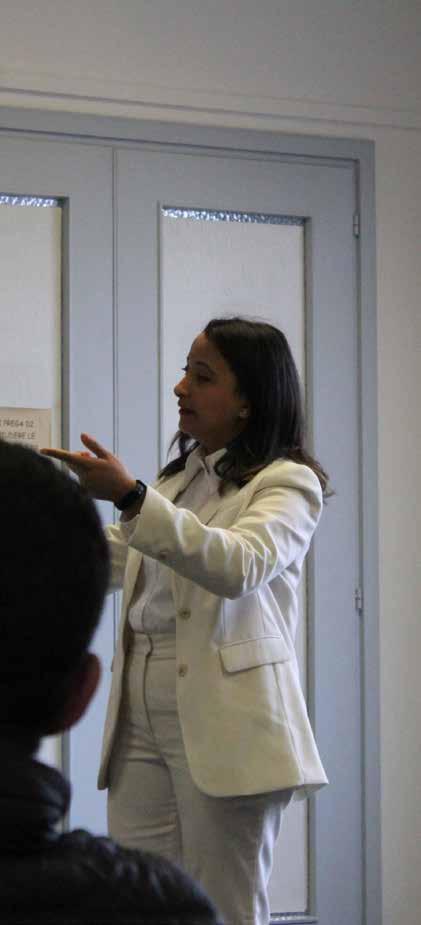
41 African Science Stars Issue 6 | www.africansciencestars.com
TUNISIA
“In 2014 I was the first student in the Republic of Tunisia to deliver a research project thesis for my bachelor’s degree in planetary science, successively in 2016 I defended my Masters thesis about the geology of Mars”
OUTREACH & EDUCATION COMMITTEE PROJECTS 2023-2024
THE AFRICAN ASTRONOMY AMBASSADORS PROGRAM
The primary goal of this program is to establish or unite a community of astronomy enthusiasts from all over Africa to conduct outreach activities, share resources and best practice methods, and to popularise astronomy among the public. The program is closely aligned with the #AfricaLookUp campaign, and aims to educate the public on astronomy and create awareness of the various career opportunities available in the industry.
THE #AFRICALOOKUP CAMPAIGN
This campaign seeks to motivate people throughout the continent to pause, gaze at the night skies, and appreciate the magnificence of our shared African skies, while drawing inspiration from the marvels of the universe.
The campaign will consist of a number of relevant activities, including:
• Encouraging the public to celebrate the African night skies by sharing their favourite African astronomy memories via online media channels.
• Engaging with African Astronomy Ambassadors to champion the campaign in their outreach efforts.
• Hosting stargazing events across Africa.
• An online astrophotography/arts competition that will aim to inspire all to share what they most love about astronomy in their local African region (night skies/facilities/starlore/ astronomy community, etc.). The collection of submissions will then be curated to serve as a glimpse into our continent’s diverse astronomy landscape.
THE GLOBAL OUTREACH PROJECT
This project targets regions in Africa with little to no astronomy activities. The basic idea is to raise awareness of the importance of having astronomy as part of the general science curricula and its multiple benefits (academically- and society-wise). The aim is also to set up milestones in these regions in order to jumpstart astronomy at the academic level under the impetus of the upcoming IAU-GA2024.
THE IAU-OAE SHAW WORKSHOP
The Office of Astronomy for Education (OAE), through the SHAW foundation, are supporting the vision of creating and building astronomy education initiatives across Africa, especially with the IAU General Assembly coming to African soil for the first time in IAU history (the IAU-GA2024, which will be held in Cape Town, South Africa, next year). This year, the African- Regional SHAWIAU Workshop on Astronomy for Education will be held in South Africa.
The aim of these IAU-SHAW workshops are to bring all stakeholders of astronomy education together, to build and share ideas on how to optimally leverage the potential of astronomy in formal education. In most parts of the world, astronomy is rarely regarded as a subject on its own and is not considered to be an important or even relevant subject. This workshop therefore aims to address the various deficiencies that arise from these challenges (for example, the lack of teachers’ content, resources and teaching strategies).
TEACHER TRAINING WORKSHOPS (WITH THE OFFICE OF ASTRONOMY FOR EDUCATION)
To ensure that teachers have adequate knowledge of astronomy, it is important for them to attend professional development workshops and conferences, as well as to stay up to date on the latest developments in the field. This particular teacher training and development program will cover astronomy topics such as the Solar System, phases of the moon, day and night, Planet Earth, seasons, constellations, and basic telescope usage. This content is mostly covered when astronomy is formally introduced around grade 4 (ages 9-10), and is relevant to learners as they are closely related to their everyday experience and knowledge. This program incorporates hands-on activities
42 African Science Stars Issue 6 | www.africansciencestars.com
and experiments, as well as strategies for incorporating astronomy into the school curriculum.
SCHOOL AND COMMUNITY VISITS
This includes a number of outreach activities at various schools and communities across the continent to popularise astronomy and run career awareness programmes. The activities will include stargazing, sky viewings, mobile planetariums, etc. All of this will be done in partnership with various other organisations in the science engagement sector.
ROADSHOWS
The first planned trip is the East African Roadshow that will be conducted with the African Science Stars Publication. The aim of this roadshow is to strengthen existing partnerships as well as establish new relationships with partners in the region, run outreach activities and workshops, as well as participate in high-level discussions with the stakeholders to promote astronomy in Africa.
ASTRONOMY CORNERS
This project aims to create astronomy awareness in schools and communities across Africa. The idea is to identify and create astronomy corners in public libraries, schools and science centres. Communities in previously disadvantaged areas are often left behind resulting in reduced growth, especially in fields of science and technology development. The aim of the Astronomy Corners project is therefore to create science awareness, with emphasis on astronomy in these communities through the supply of books and informative material.
PORTABLE AND AFFORDABLE RADIO TELESCOPES IN SCHOOLS (PARTS) AND RADIO ASTRONOMY WORKSHOP
Radio astronomy is currently transforming the field with its state-of-the-art telescopes and their unprecedented high resolution and sensitivity (a good example being the MeerKAT radio telescope array, a precursor to the upcoming Square Kilometre Array). On one hand, the huge amount of data that will come from these facilities in the near future will demand a boost in the astronomy workforce. On the other hand, long-term operation and maintenance of these telescopes requires skilled indigenous astronomers, engineers and technicians. Thus,
huge efforts are needed to raise a future generation of radio astronomers and engineers, primarily by igniting interest in STEM-related subjects among students at an early stage in their careers (i.e. undergraduates). This can be achieved by engaging students with hands-on activities using teaching tools such as radio telescopes. However, in developing countries these telescopes cannot be easily assessed due to unavailability, expensive telescope time and/or lack of expertise to locally fabricate cheap and effective equipment. This project focuses on the production and distribution of a low cost affordable and portable do-it-yourself educational radio telescope package. It is a highly multi-disciplinary project involving mechanical engineering and mathematics during the design and assembly, electronic engineering during the digital signal processing, computer science through the use of python programming language in data acquisition and reduction, and physics through concepts like Fourier series, radio waves, doppler effect, motion of galaxies (to mention but a few).
ASTRONOMY FOR MENTAL HEALTH VIDEO PRODUCTION
Mental health is a growing concern globally, and there is a need for innovative approaches to promote wellbeing. During this project, we will collaborate with the Office of Astronomy for Development (OAD) to create multimedia content that highlights the positive effects of astronomy on mental health. The video production will create a tranquil and immersive experience for viewers, helping them to find solace and peace amidst the vastness of the cosmos. By reaching a broad audience, the project will help raise awareness of the mental health benefits of astronomy, promoting wellbeing and positive mental health. The project will have a phased approach, with outcomes that are designed to benefit the maximum number of people during each phase. During Phase 1, we aim to produce a short ~5-minute 2D film that can be easily distributed on social media. This will then be expanded to full-length fulldome (planetarium) and Virtual Reality films during Phase 2.
ONLINE ASTRONOMY COMPETITIONS
The aim of this competition is to raise awareness about astronomy by targeting a younger audience. This is planned to be a fully virtual competition to ensure a broad reach and will have three sub-categories based on grade/age. The categories are primary school learners (7-13 years), high school learners (14-18 years), and undergraduate students (19-~24 years).
43 African Science Stars Issue 6 | www.africansciencestars.com EVENTS
African Science Stars on the move!

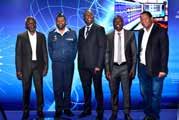
THE NATIONAL SPACE CONFERENCE
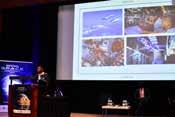
The National Space Conference took place from 31 August to 1 September 2023, under the theme “Space for Inclusive Growth”. Attendees had the opportunity to participate in various presentations, panel discussions and technical sessions covering a wide range of space topics. Participants could also explore the exhibition area, which saw 21 exhibitors take part and showcase their entities.
BIUST MAX-PLANCK AFRICAN ASTRONOMY SCHOOL
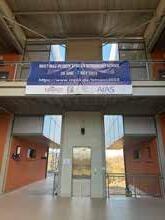
From 26 June to 7 July the BIUST MaxPlanck African Astronomy School took place in Palapye, Botswana. The two entities collaborated and the primary goal of this event was to facilitate the transition for students from undergraduate to graduatelevel astronomy research.

RHODES HIGH SCHOOL
We paid a visit to Rhodes High School in Cape Town to participate in a career day event. Several guest speakers shared their personal experiences with the aim of motivating the ninth-grade students to consider pursuing STEM careers.

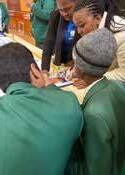



44 African Science Stars Issue 6 | www.africansciencestars.com GALLERY
NATIONAL SCIENCE WEEK LAUNCH
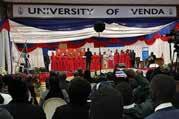
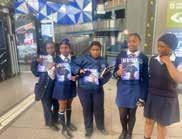

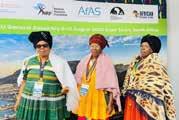
The African Science Stars team arrived in Thohoyandou, Limpopo, for the launch of the National Science Week under the theme “Transforming lives through the evidence-based science” at the University of Venda (UNIVEN). In a speech, Dr Blade Nzimande, the Minister of Science and Innovation, emphasised the significance of science and the accomplishments of both the university and South Africa in the field of science. He also officially inaugurated National Science Week.
NATIONAL SCIENCE WEEK
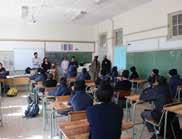
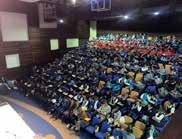
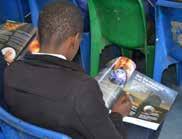
The African Science Stars team participated in the National Science Week in the Free State’s Fezile Dabi district. During this event, the outreach team engaged with over 400 learners, ranging from grades 4 to 9, making science and astronomy captivating while demonstrating various ways of conveying scientific concepts.

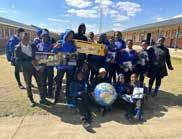
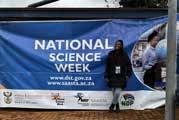
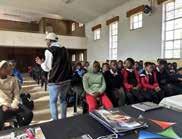

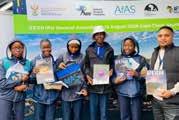
SCI-BONO DISCOVERY CENTRE
The Sci-Bono Discovery Centre in Johannesburg hosted the annual girl-learner program under the theme “Non-linear career paths and mentorship: Risks, sacrifices and rewards of pursuing a passion”.
SUTHERLAND

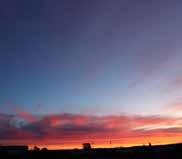
The outreach team visited the Northern Cape, home to the Southern Hemisphere’s largest optical telescope, SALT, from 6-8 September. The visit included a careers day at Sutherland High School, stargazing activities and delivering the Astrotourism Edition of the magazine to the SALT visitors’ center for all to enjoy.
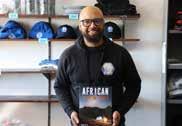
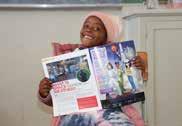
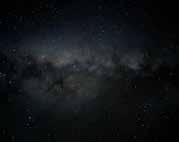
45 African Science Stars Issue 6 | www.africansciencestars.com GALLERY
LET US HELP YOU GET A JOB!
NRF SARAO has a couple of jobs lined up for you in South Africa and abroad. NRF SARAO has jobs that range from a field technician, Deployment and Maintenance Manager – SKA-Low Telescope to Senior Field Technician. These jobs are in South Africa and Australia.
For more jobs on the SKA project please go to the SARAO website.
• Position: Senior Field Technician
• Location: Geraldton, Western Australia,
• Company: CSIRO
• Tenure: Indefinite – Full-Time, PartTime or Job-Share
• Reference: 93576
Role in the SKA-Low team
• constructing, assembling, and basic integration of the world’s largest lowfrequency radio telescope.
• Creating efficient and improved processes and procedures during construction and into operations.
• Additionally, this role will play a key part in recruiting the first team of technicians, and in overseeing their work during construction and maintenance. This role requires leadership, knowledge of RF systems, commitment to safety, and process improvement skills.
Responsibilities
• Recruit, manage, and develop a diverse team of technicians, fostering a safety-conscious and continuous learning environment.
• Assemble and deploy components of the SKA-Low telescope, with emphasis on the RF systems.
• Carry out level 2 integration to ensure the seamless functioning of the telescope.
• Carry out regular check-ups, maintenance and repairs on telescope systems once operational, diagnosing and fixing RF system issues.
• Supervise and work with contractors during the construction and maintenance phases, ensuring adherence to the highest standards.
Requirements
• Experience in using test and measurement instruments and their control software.
• Experience with fibre optic systems, including cable management, splicing, and testing.
• Certificate in training and assessing.
• Experience working in remote environments.
To inquire about this role and closing dates, email the SKA-Low Head of Engineering, Angela Taela, at angela.taela@skao.int
What to include in your application
• Your latest CV.
• A cover letter clearly addressing the essential criteria of this role and your motivation for applying.
This article does not contain all the job listings.
The website can be a useful resource for locating training programs geared towards recent graduates.
For additional details and instructions on how to apply, please visit the source: ess.nrf.ac.za
To view more jobs online, visit jobs.csiro.au/
46 African Science Stars Issue 6 | www.africansciencestars.com
JOBS
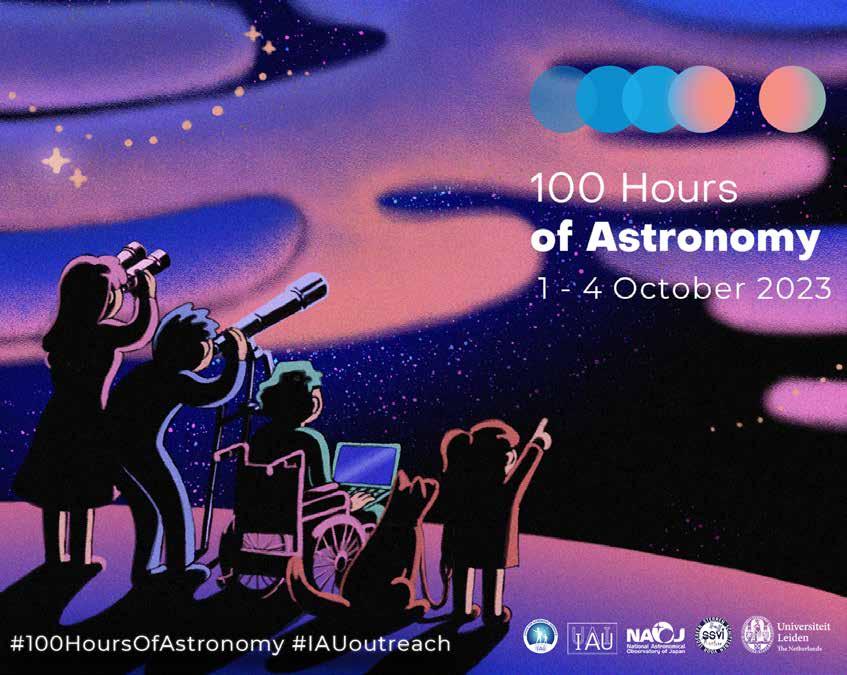
Origins Centre Origins Centre
Origins Centre is a world-class museum in Johannesburg, South Africa. The museum provides visitors with an experience of Africa’s extraordinary, rich and complex heritage, with exhibits that take visitors on a journey through the African pastcelebrating indigenous innovation, art and culture.
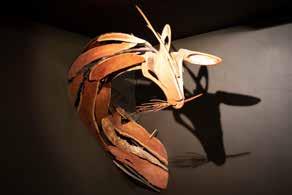
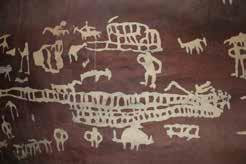
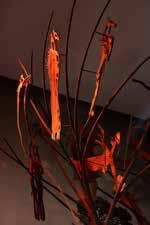
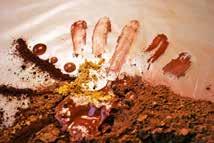
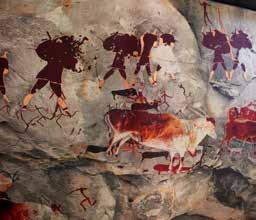

Guests can enjoy a range of offerings from temporary exhibitions, workshops and lectures to augmented reality experiences, guided tours and interactive family activities. The museum offers unique event spaces for conferences, dinners, awards ceremonies and workshops.
Follow us on Social Media
@originscentre
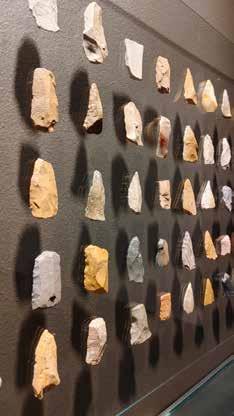
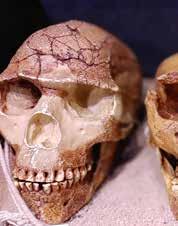

@originscentre wits

www.wits.ac.za/origins
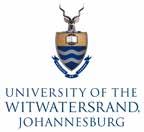
bookings.origins@wits.ac.za; +27117174700
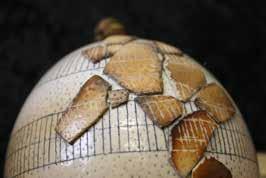

Explore Origins Centre virtually on Google Arts and Culture!
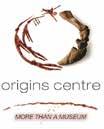
















 South African Astronomical Observatory | University of Cape Town
South African Astronomical Observatory | University of Cape Town


















 s engineering
s engineering










































 By: Lusanda Tamesi
By: Lusanda Tamesi




















































